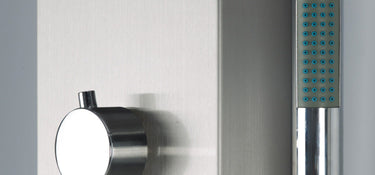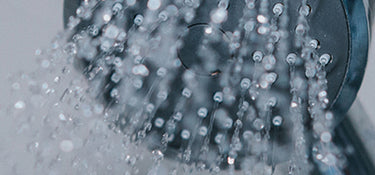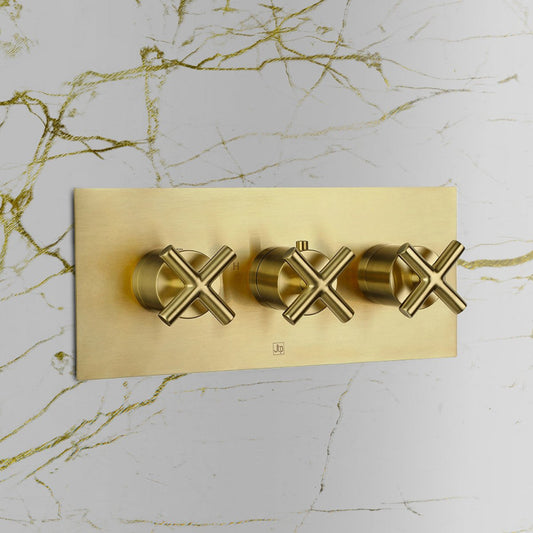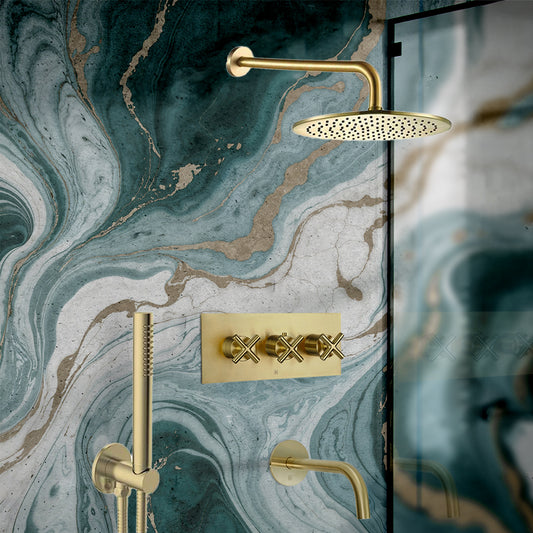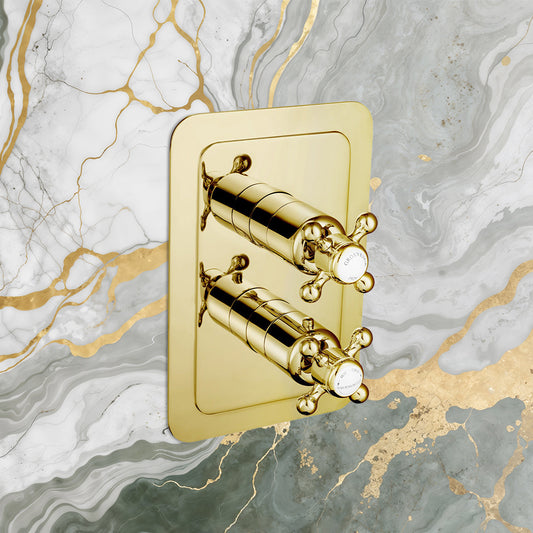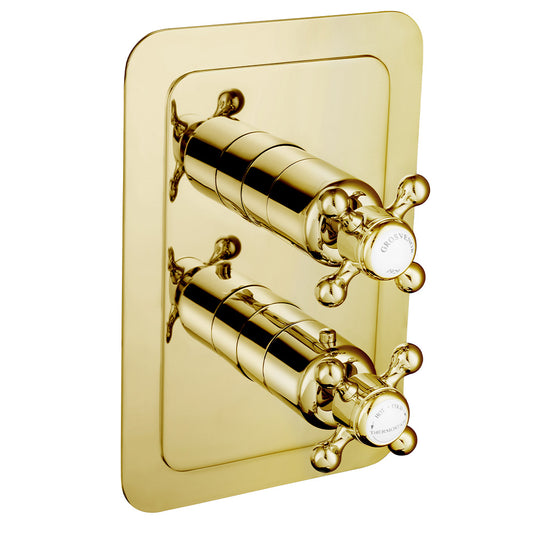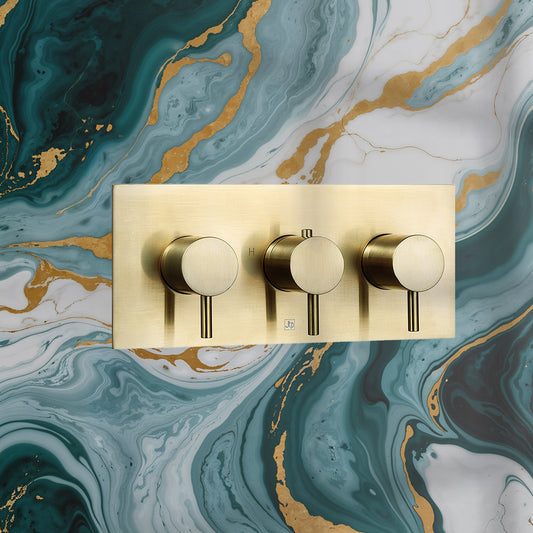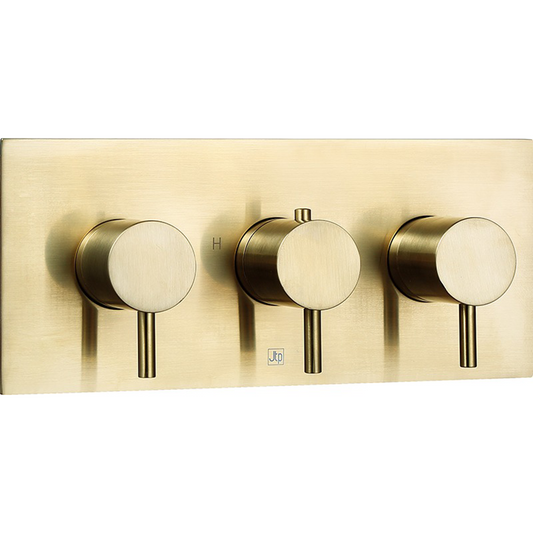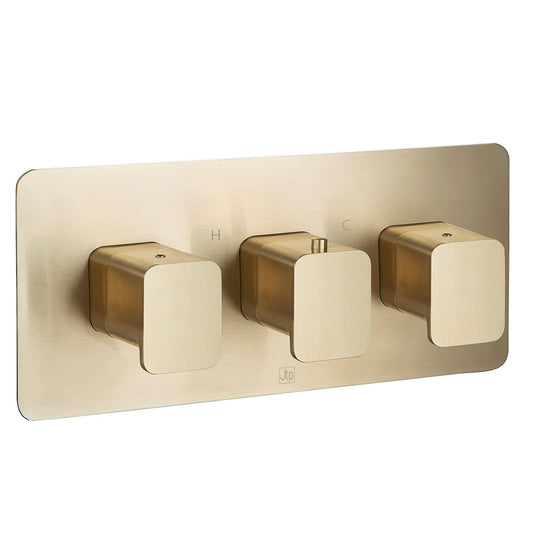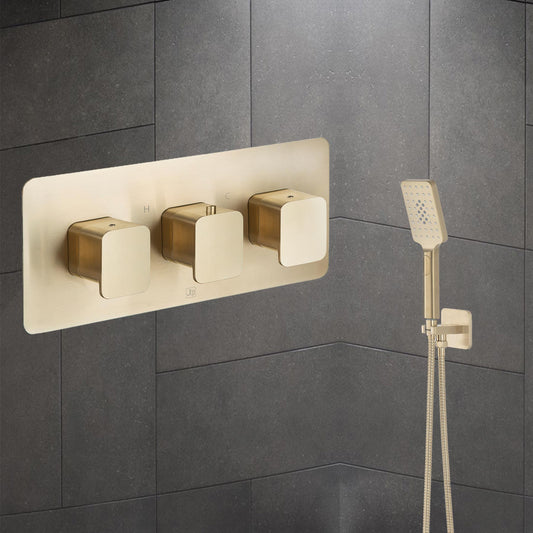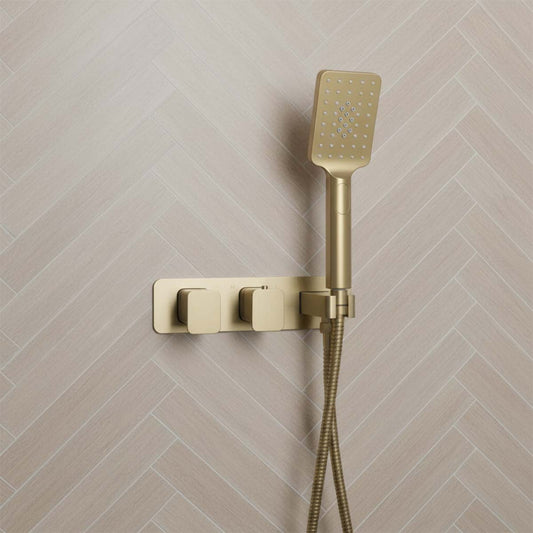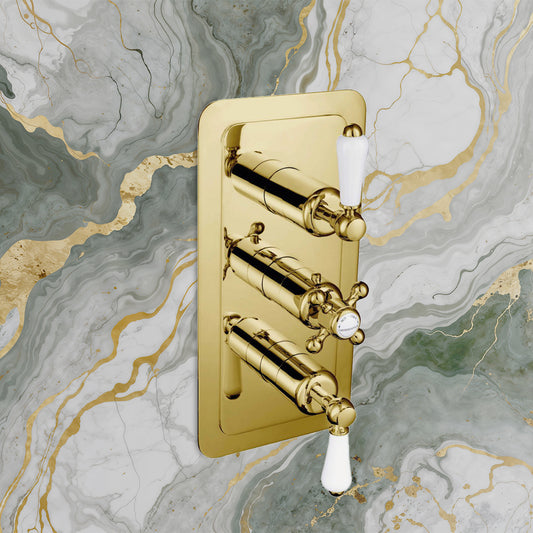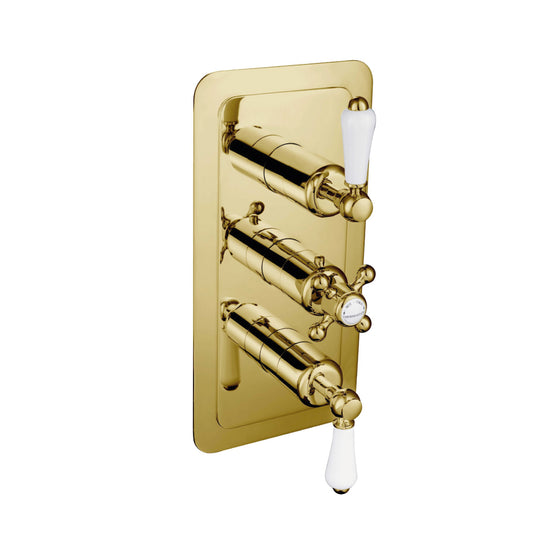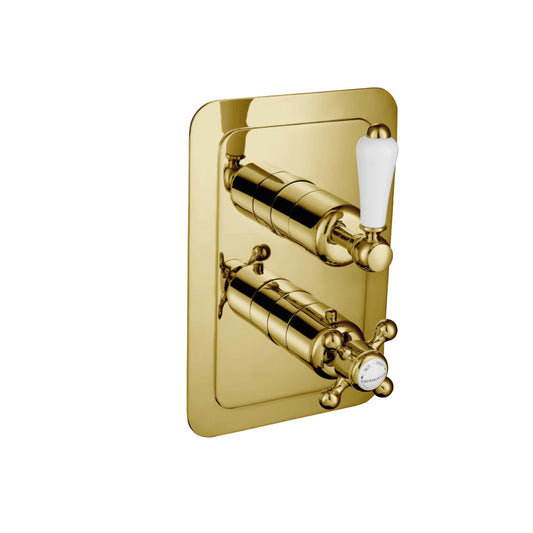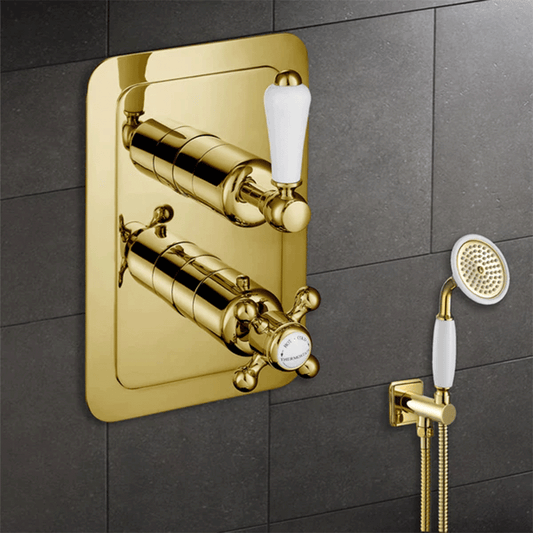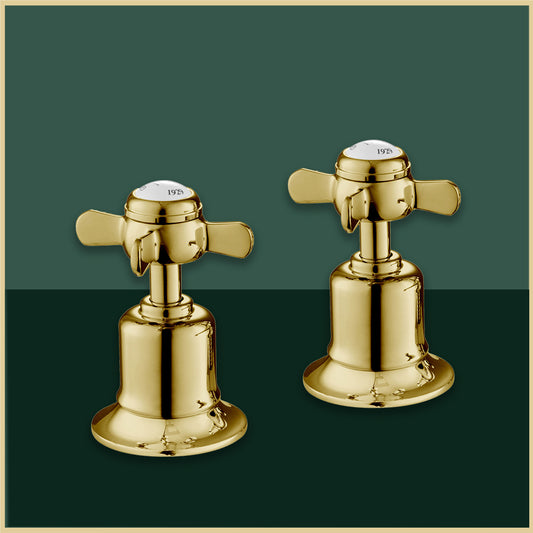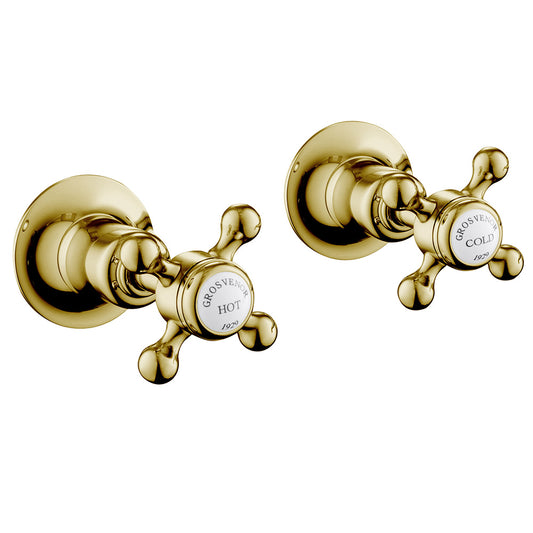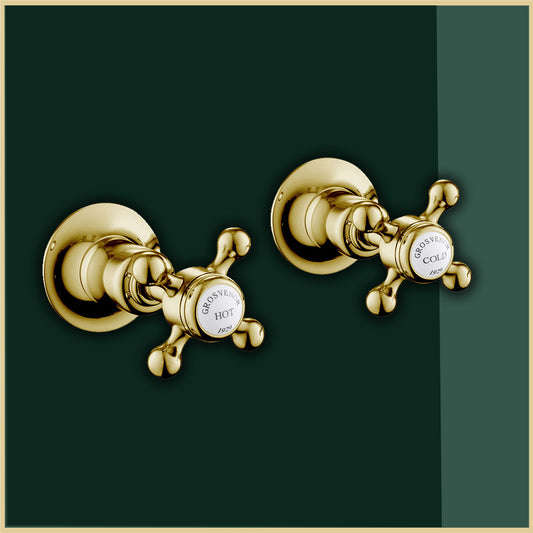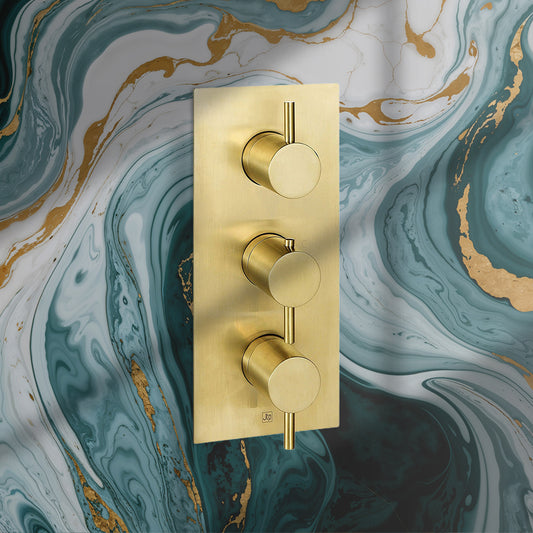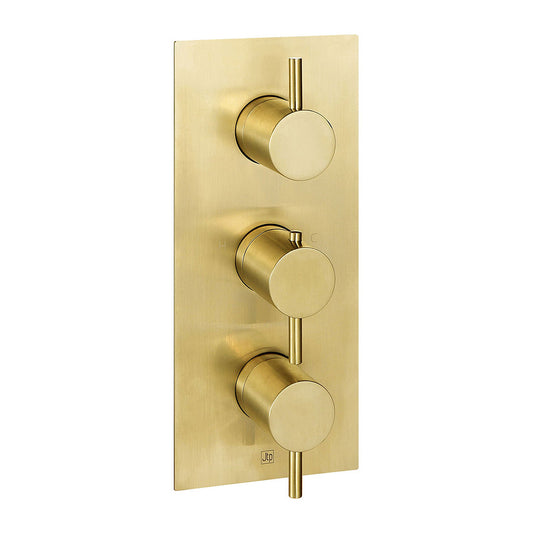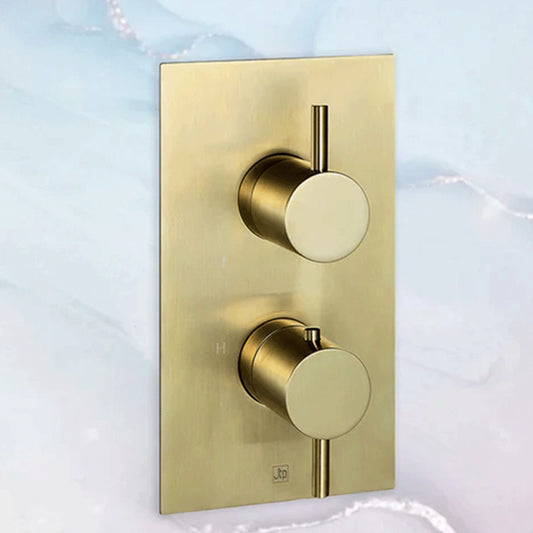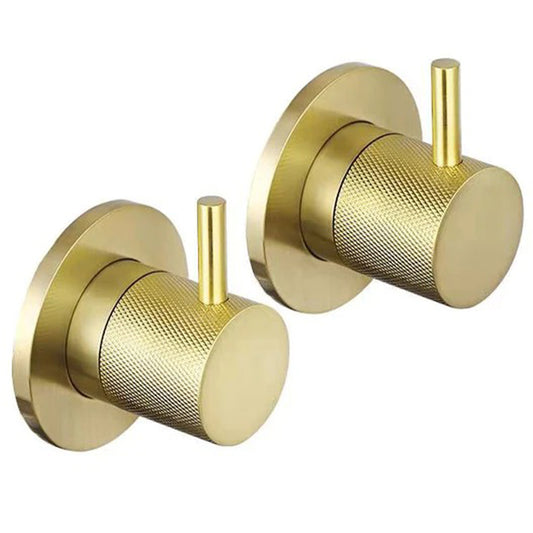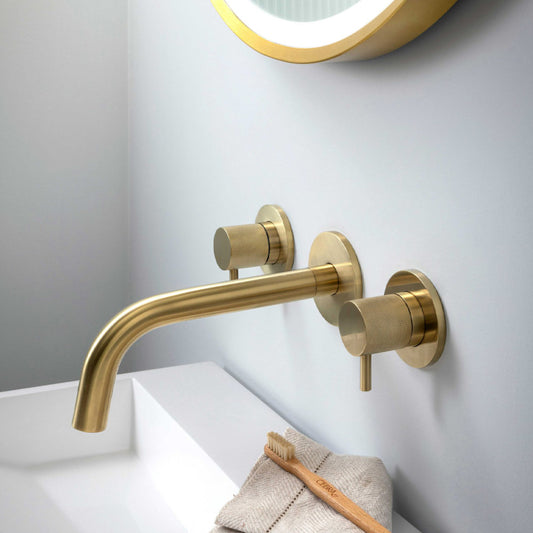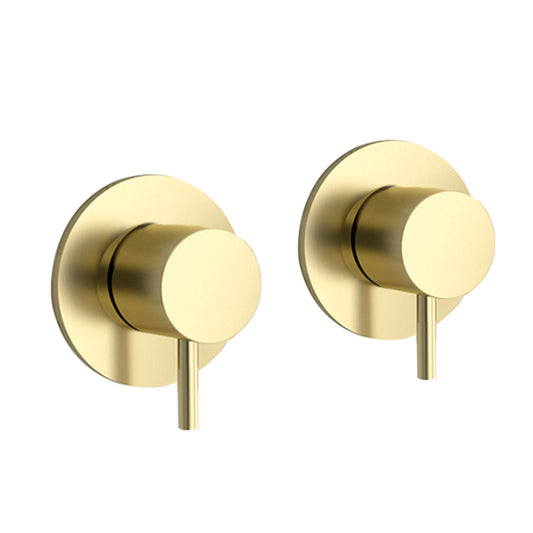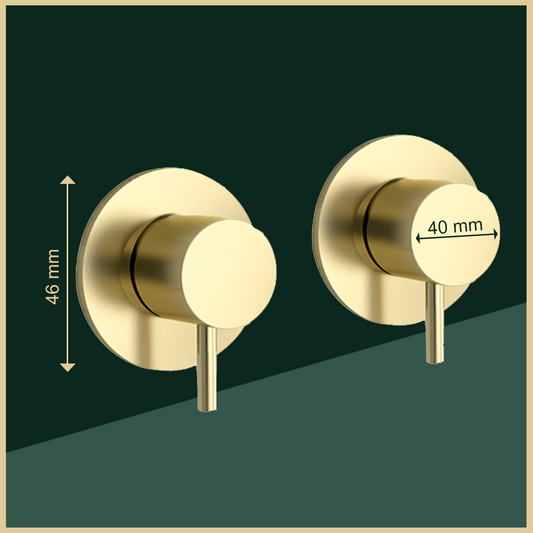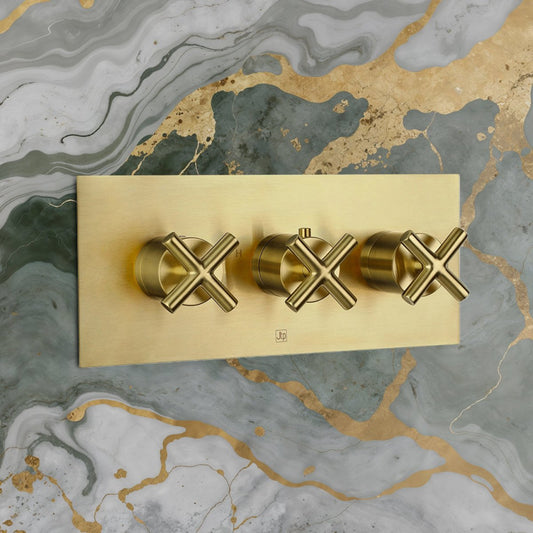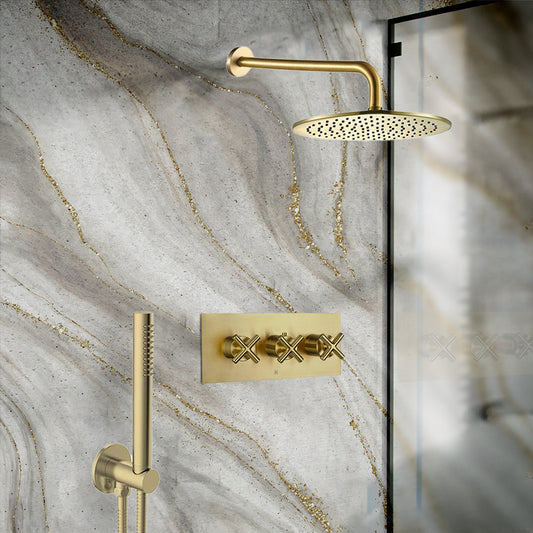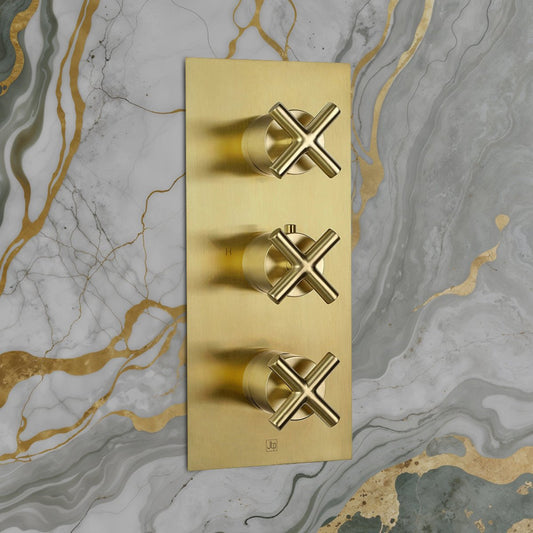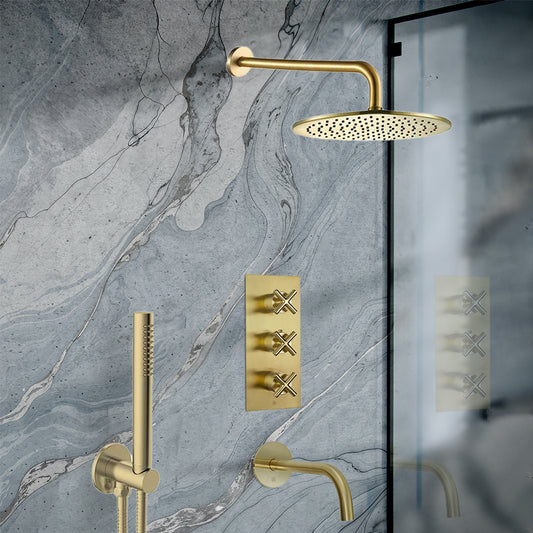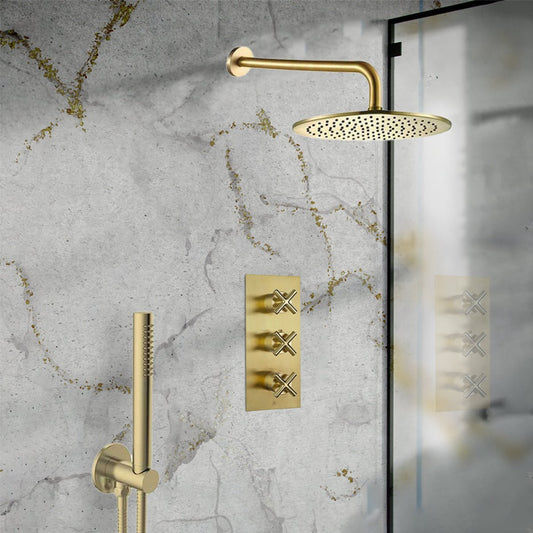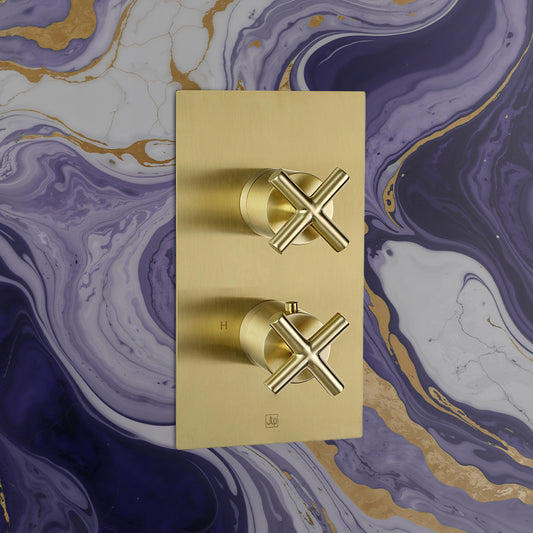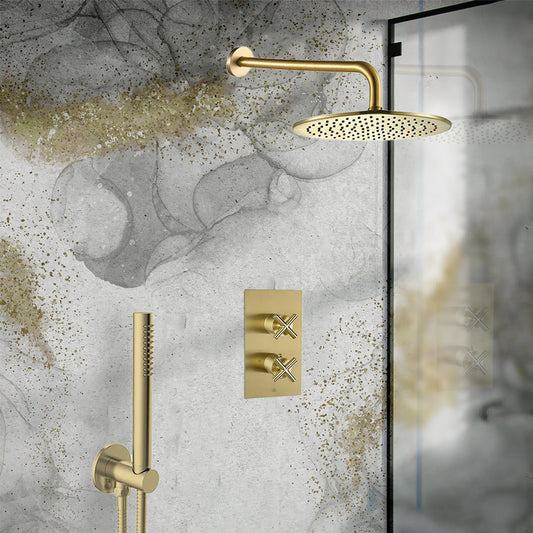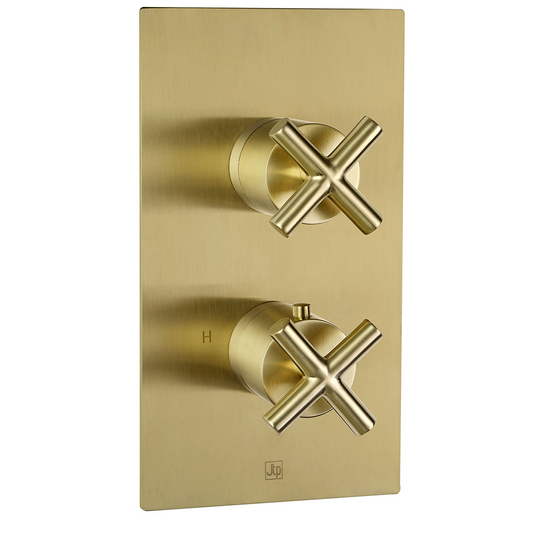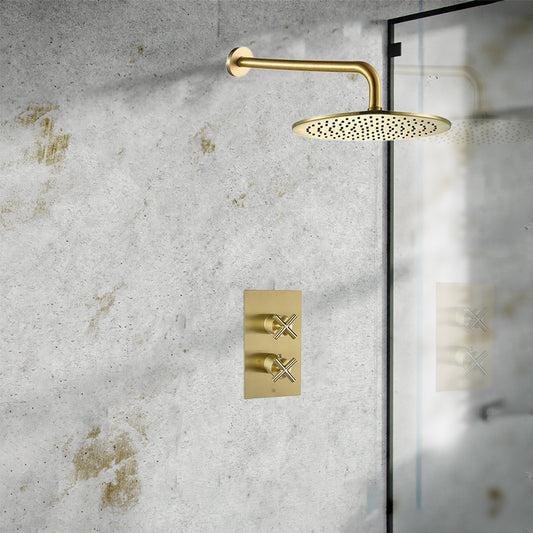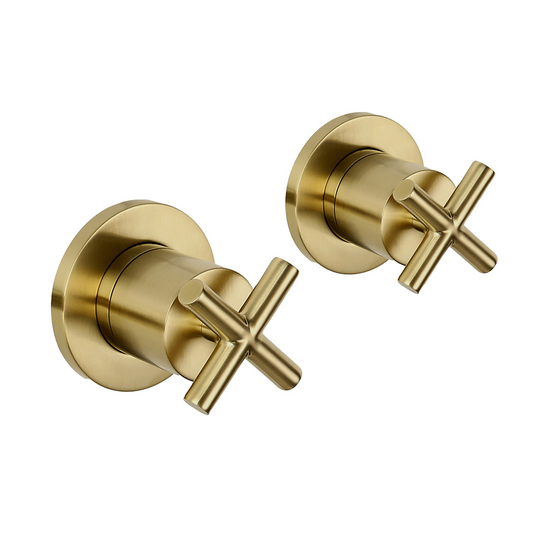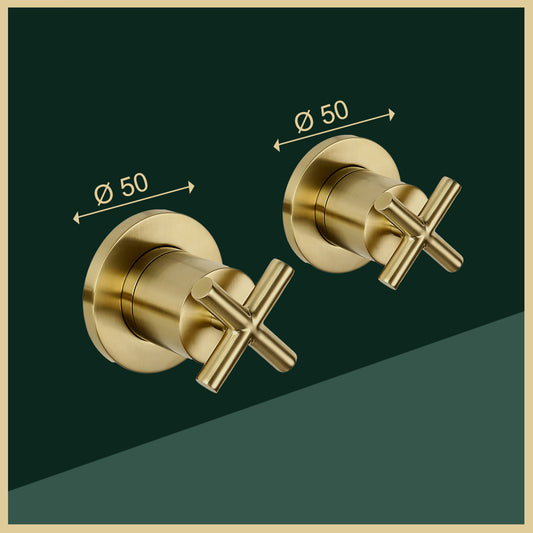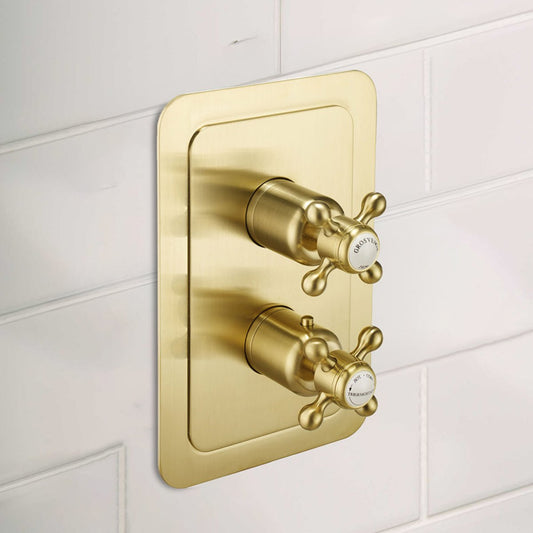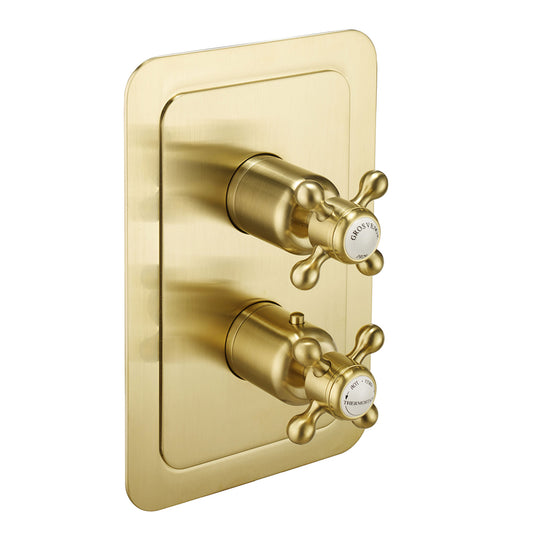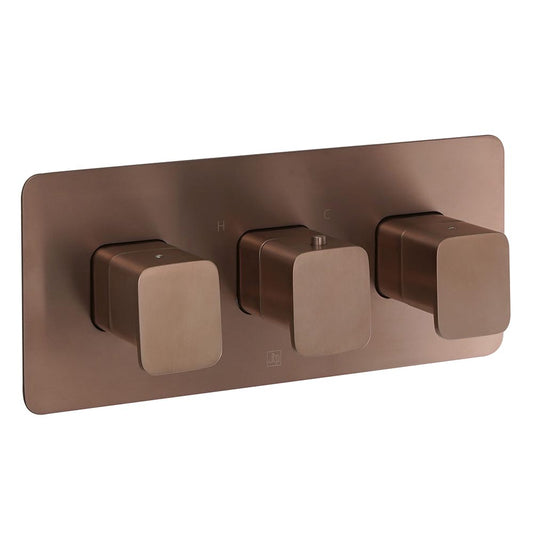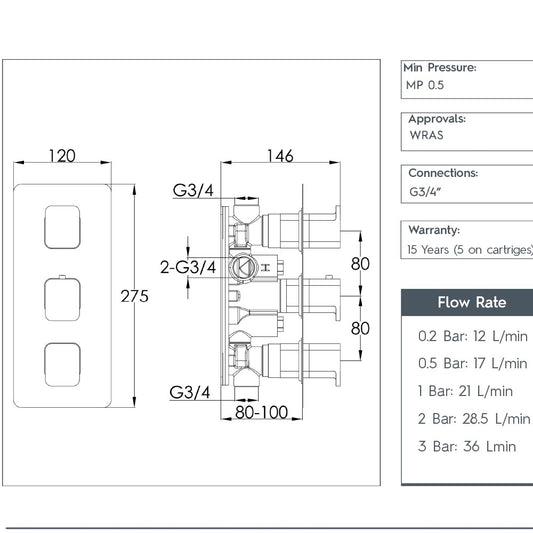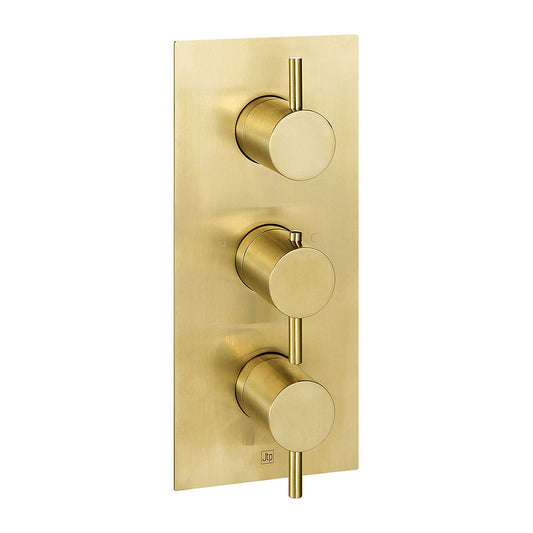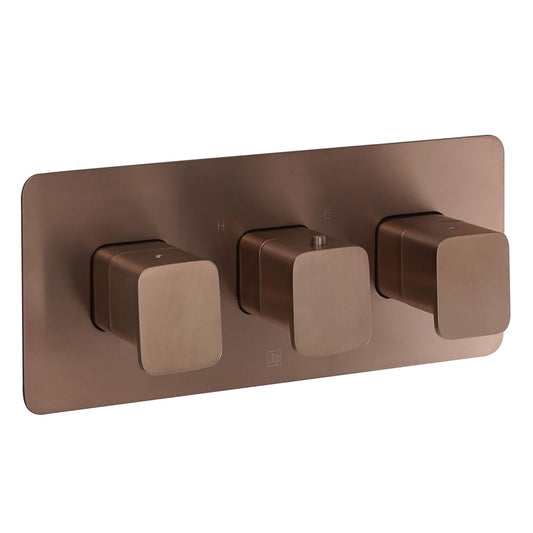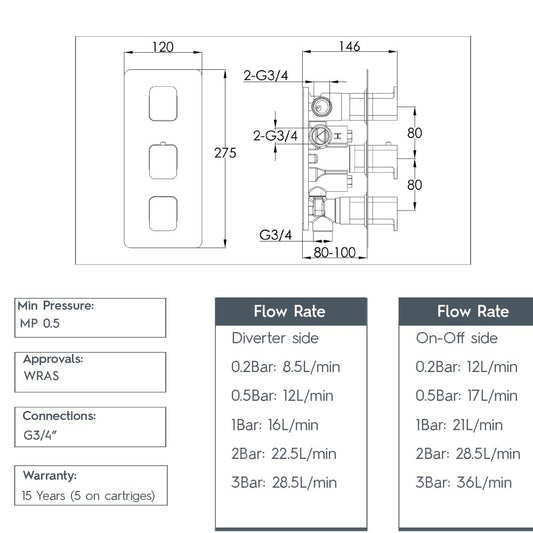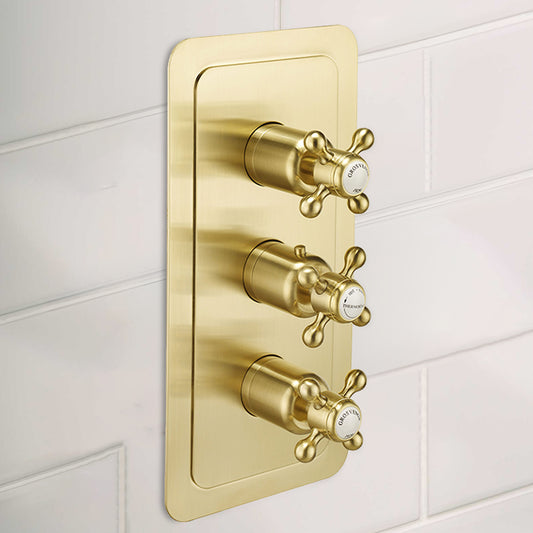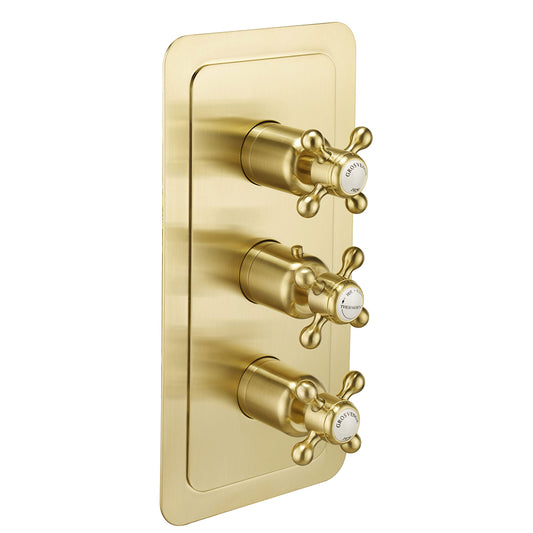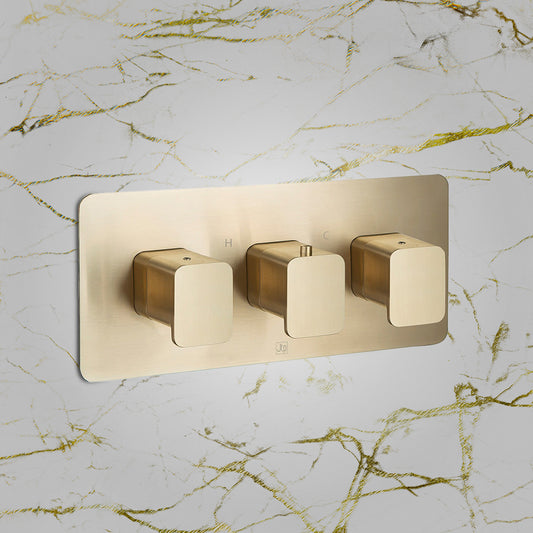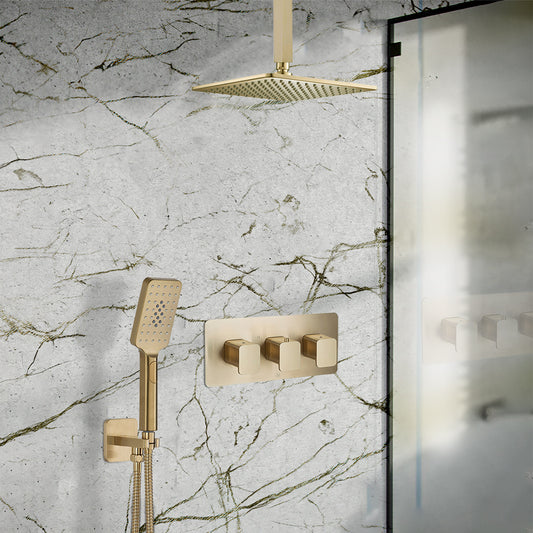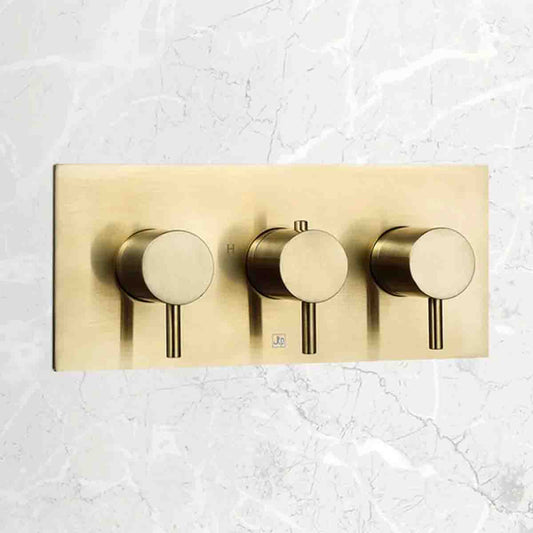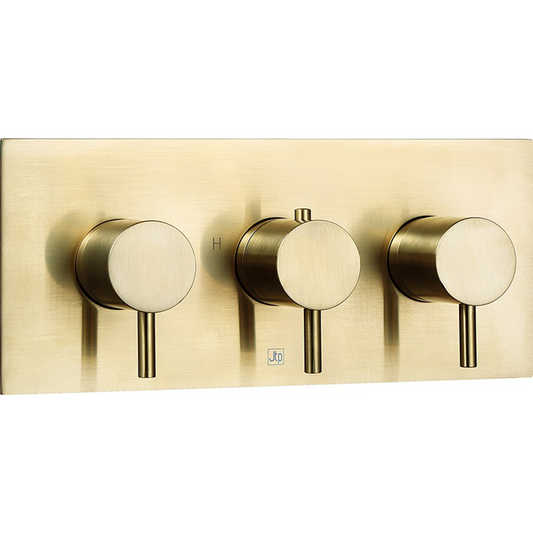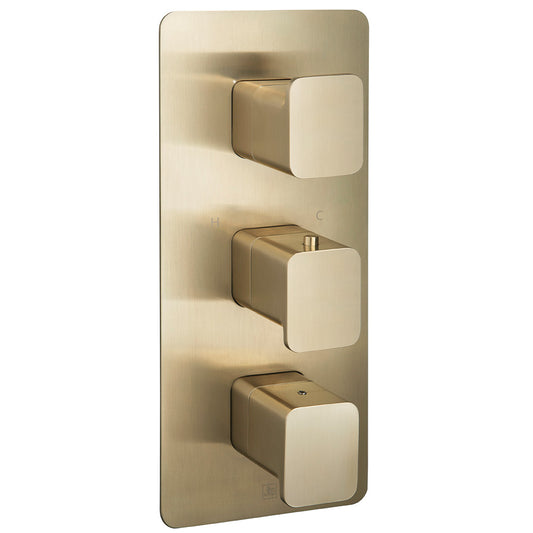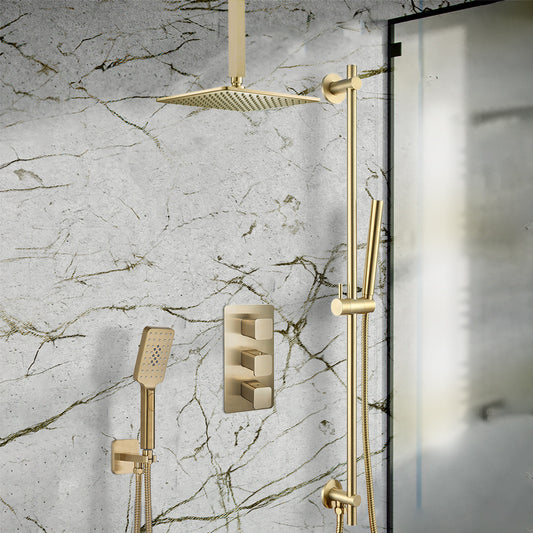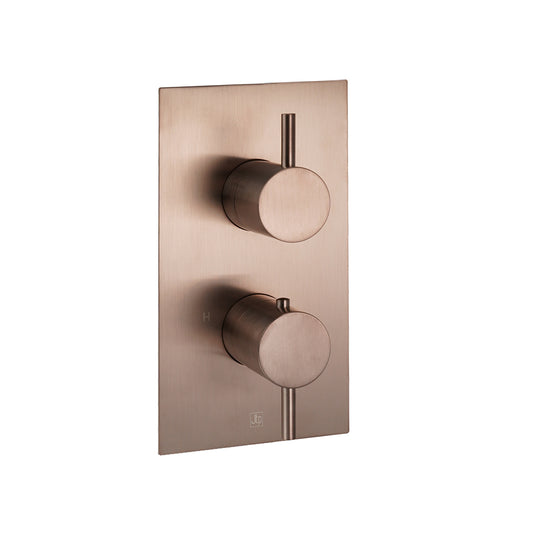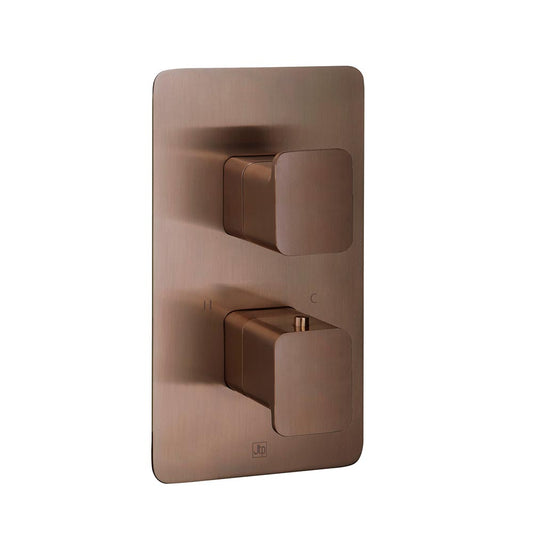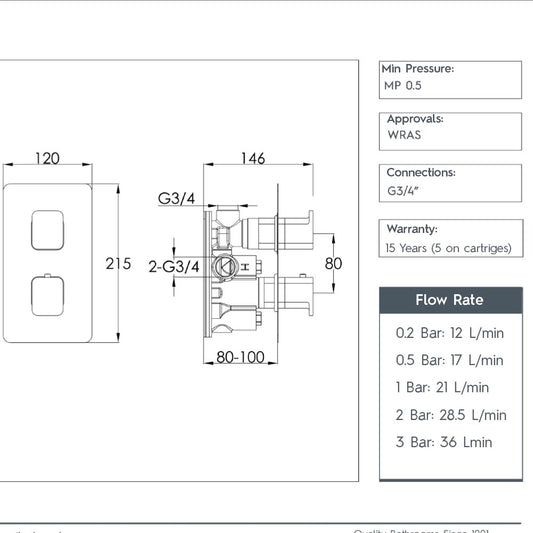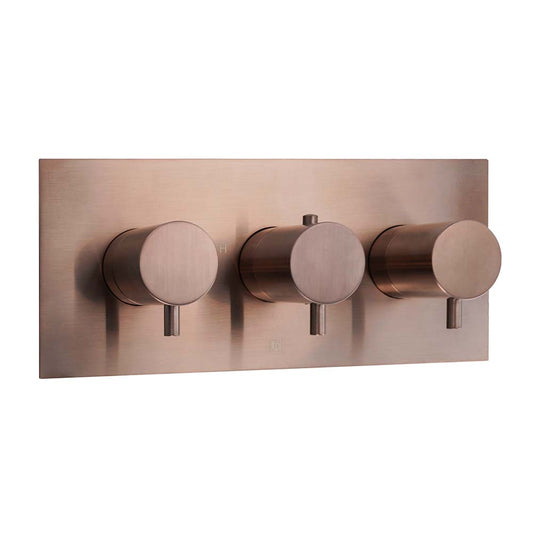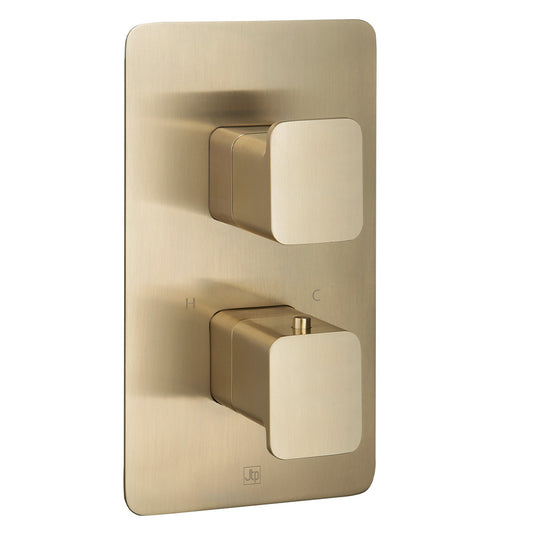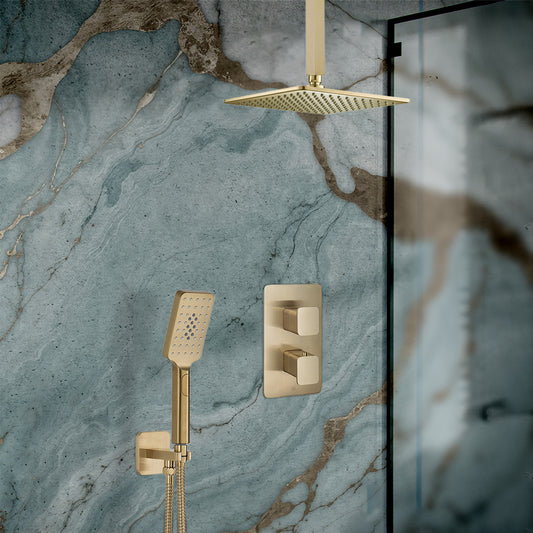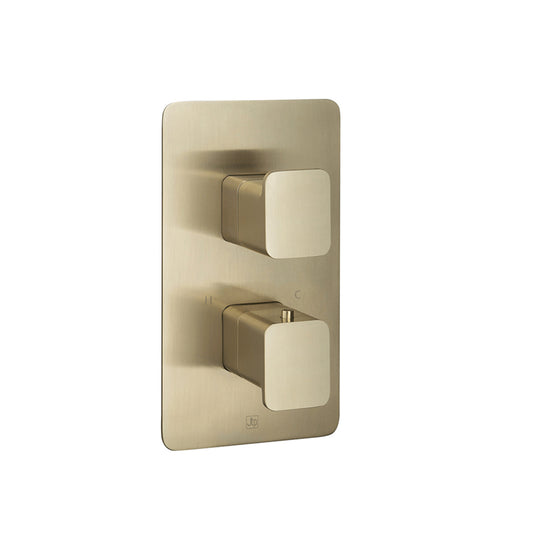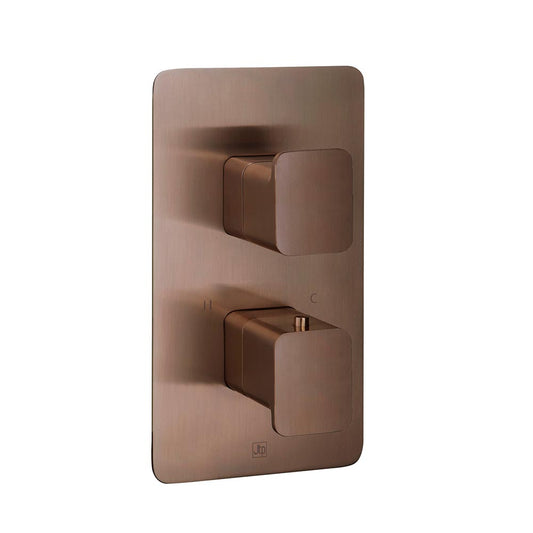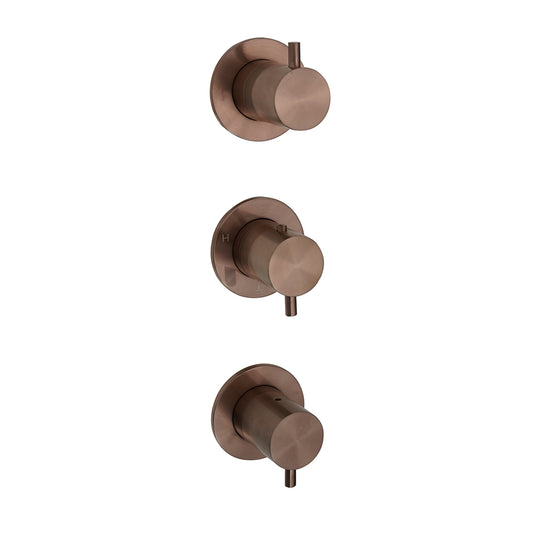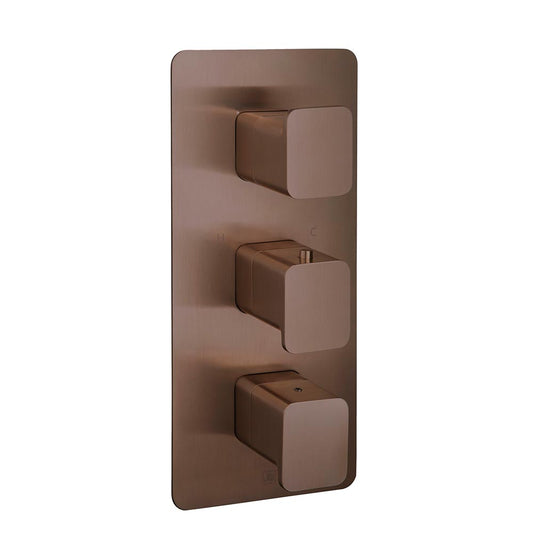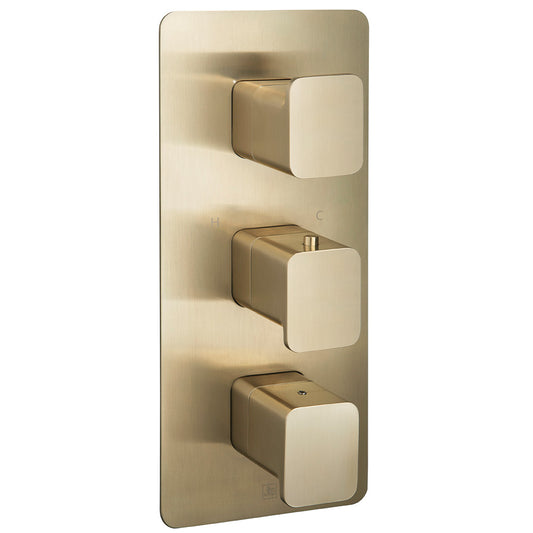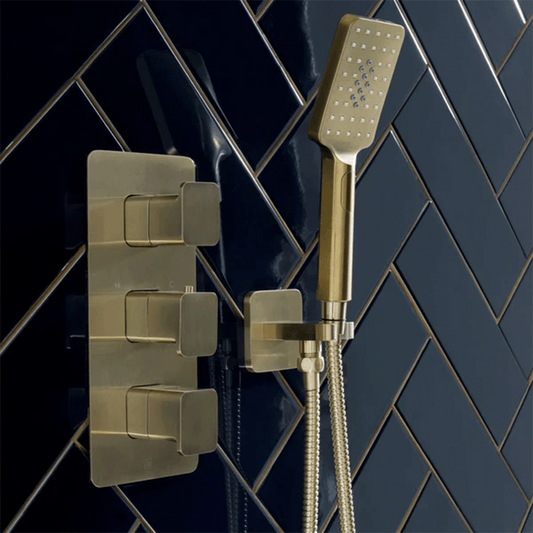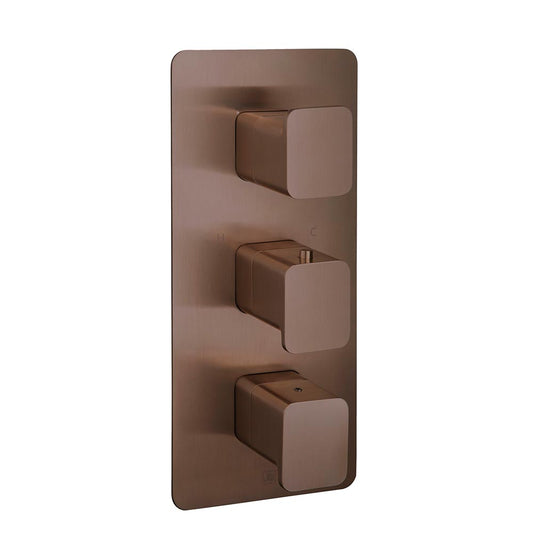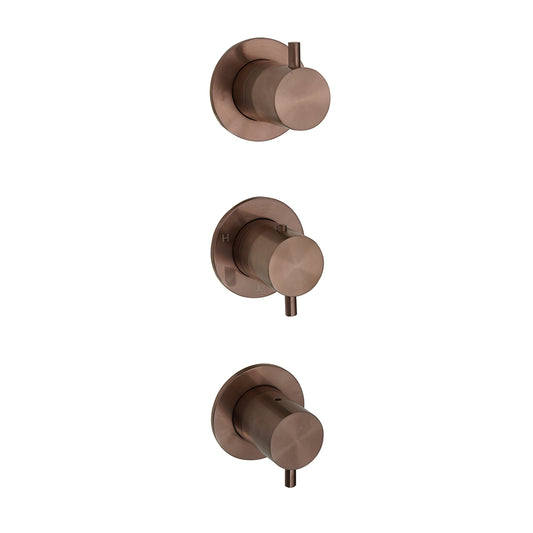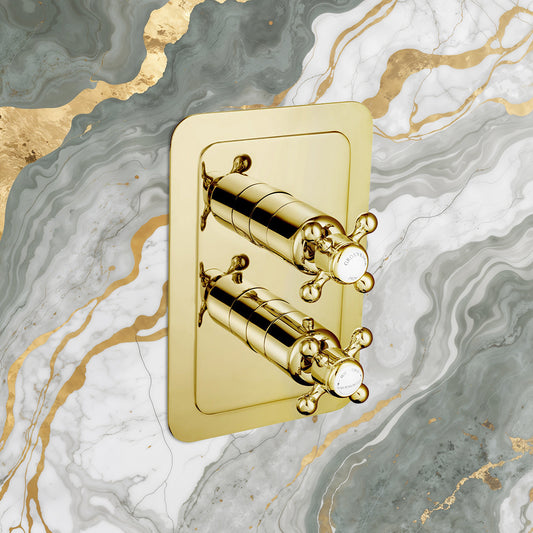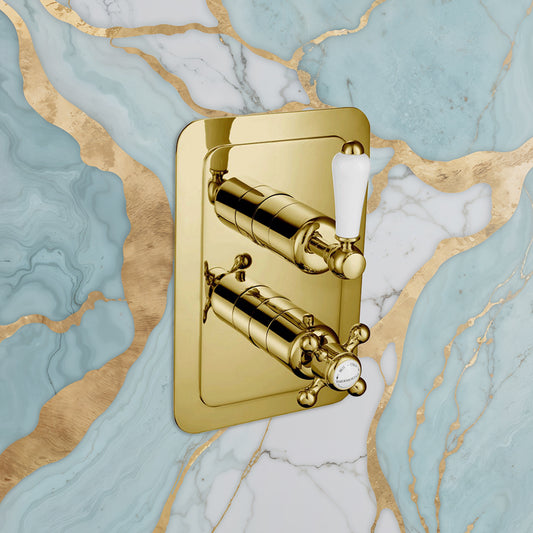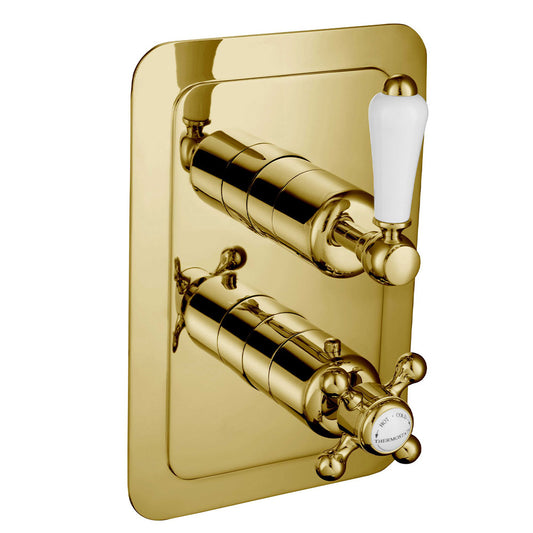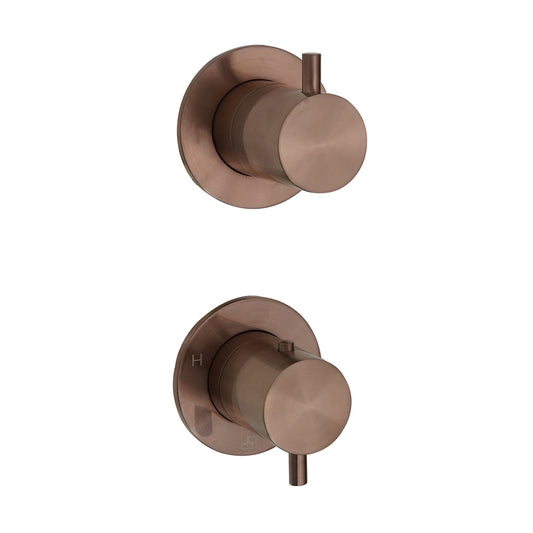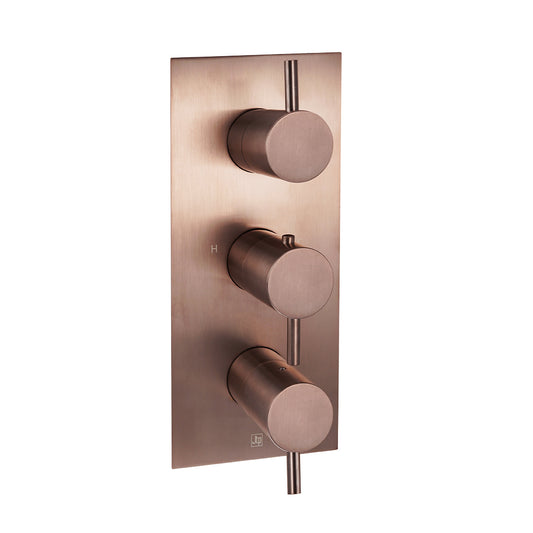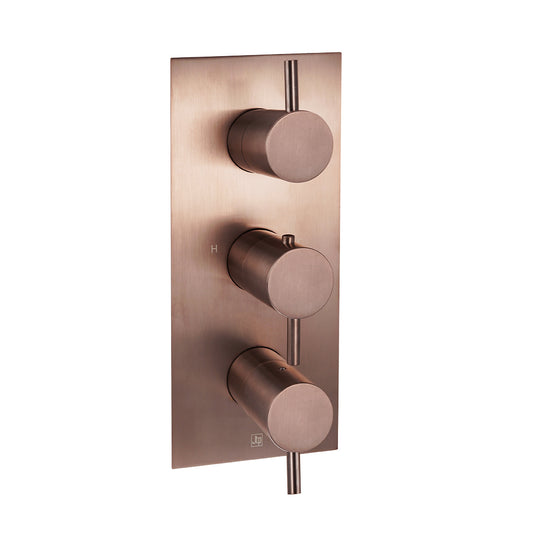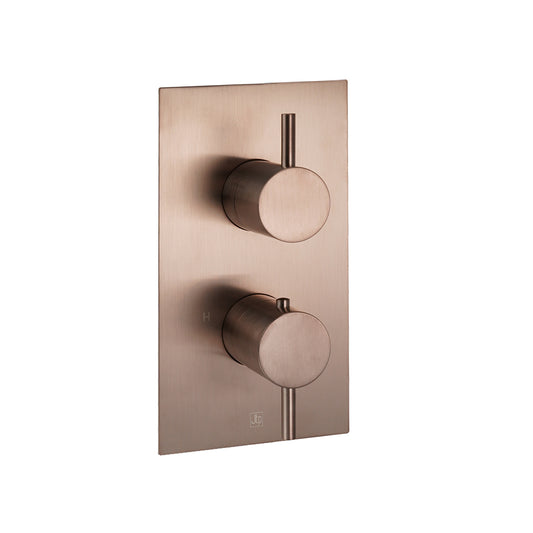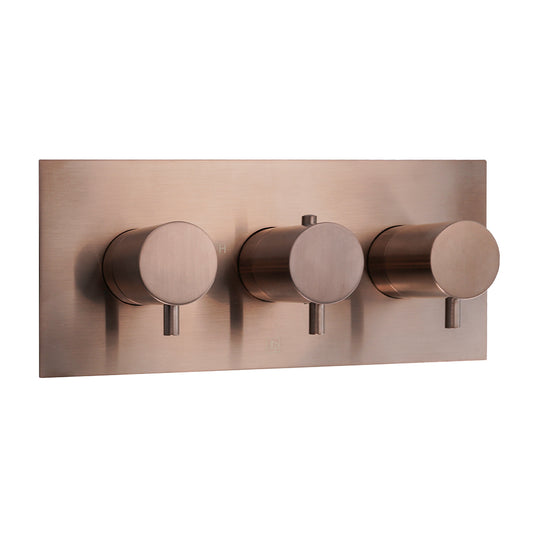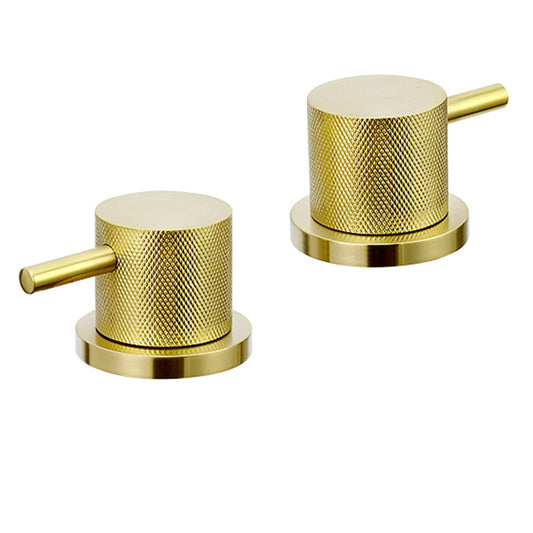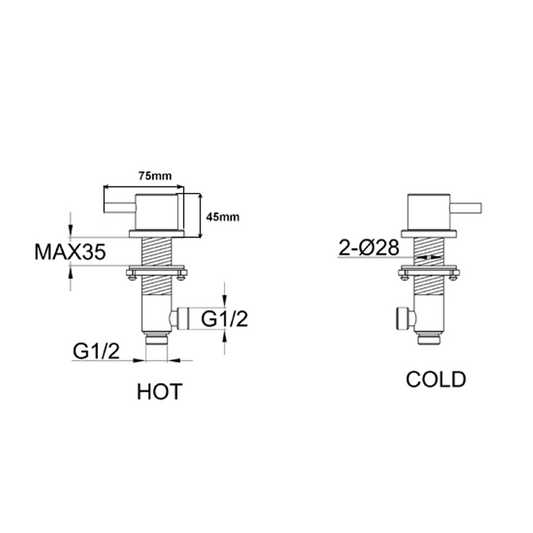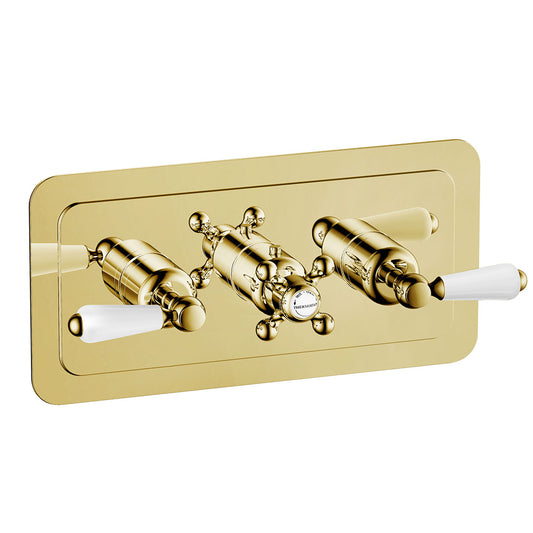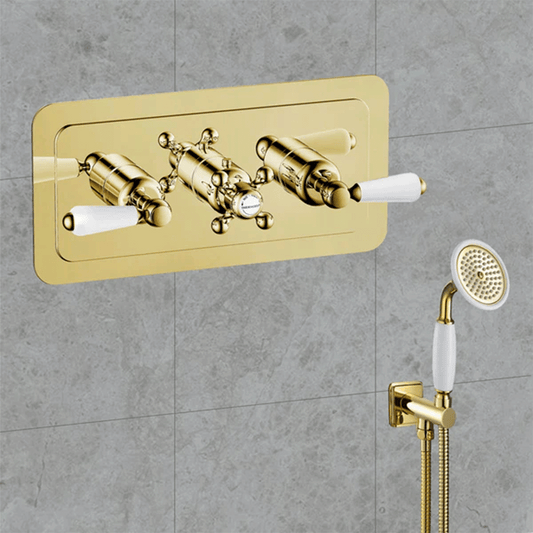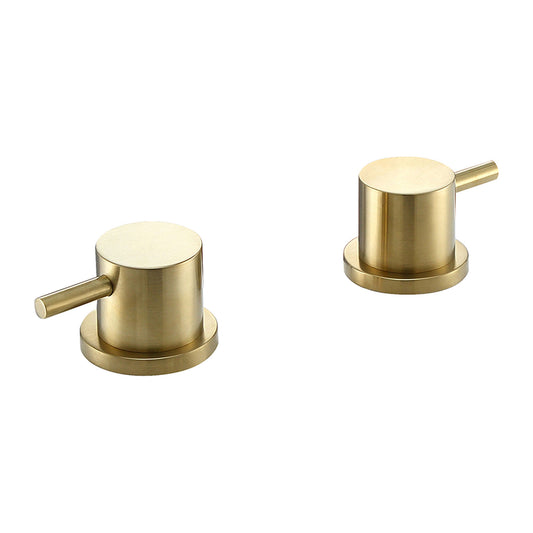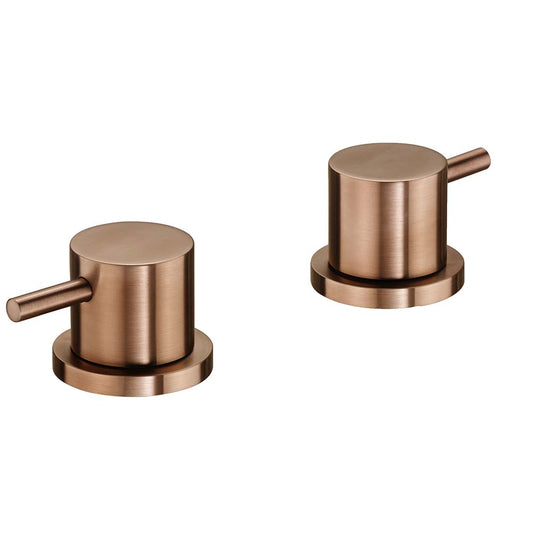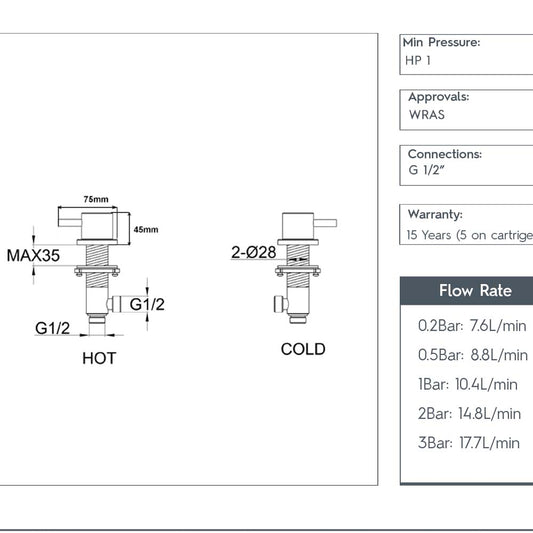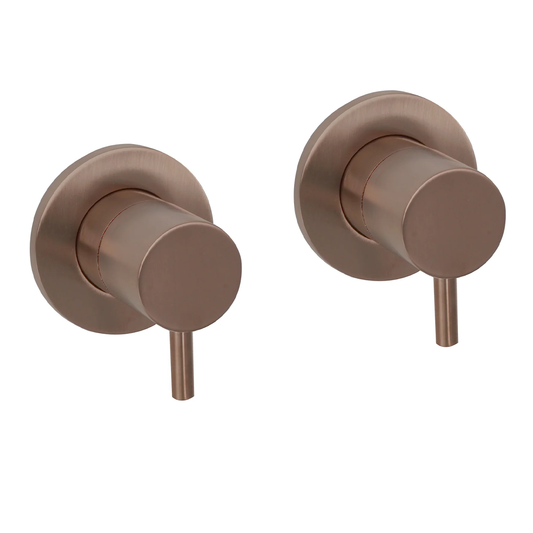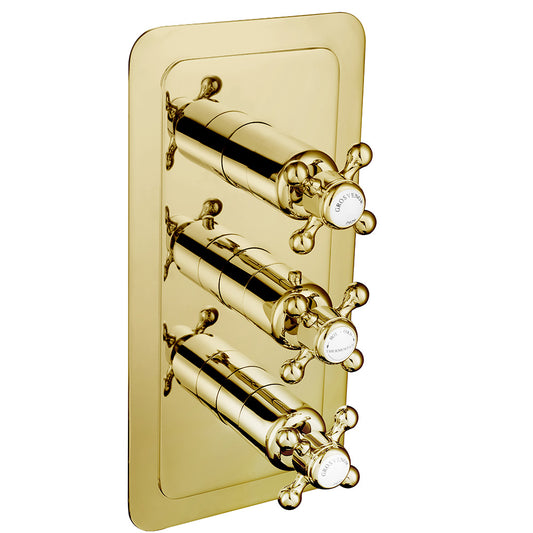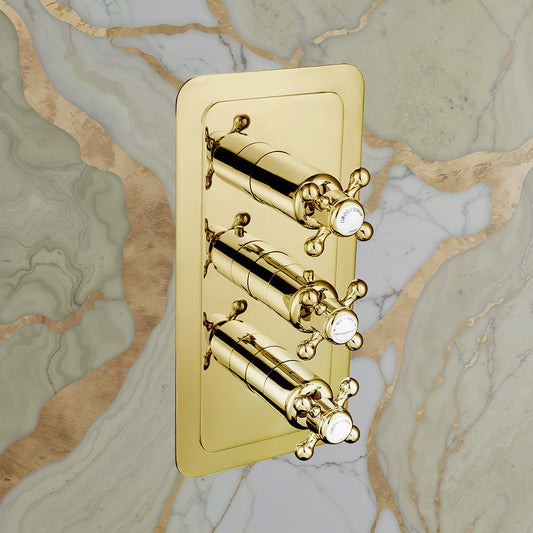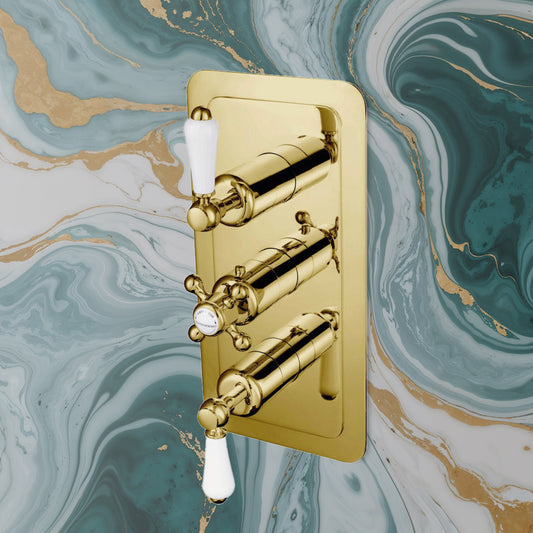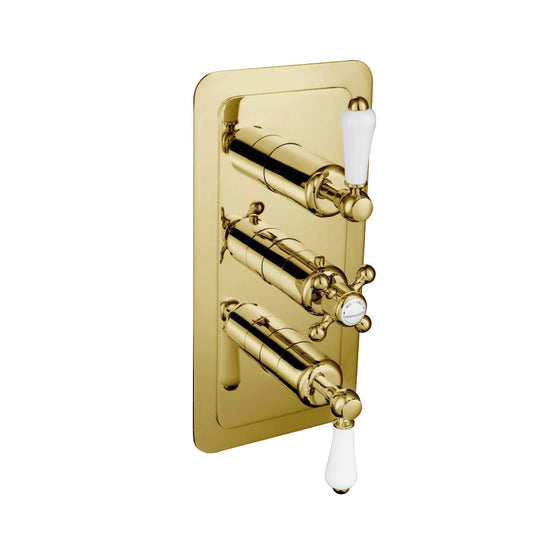Mastering the Flow: The Ultimate Guide to Choosing Shower Valves
Table Of Contents:
-
Introduction
→ -
Shower Valves Collection
→ -
What is a Shower Valve?
→ -
How Does a Shower Valve Work?
→ -
Key Components of a Shower Valve
→ -
The Importance of Choosing the Right Shower Valve for Your Bathroom
→ -
Types of Shower Valves
→ -
Key Factors to Consider When Choosing the Perfect Shower Valve for Your Bathroom
→ -
How to Install a Shower Valve: A Step-by-Step Guide
→ -
Understanding the Cost of Shower Valves in the UK
→ -
Exposed Shower Valves vs Concealed Shower Valves: Which One is Right for Your Bathroom?
→ -
Outlets in a Shower Valve: Understanding the Different Water Flow Options
→ -
Thermostatic vs Manual Shower Valves: Which One is Right for You?
→ -
Modern vs. Traditional Shower Valves: Choosing the Right Style for Your Bathroom
→ -
Essential Tips for Maintaining Your Shower Valve for Optimal Performance
→ -
Conclusion: Master Your Showering Experience
→ -
Frequently Asked Questions
→
Introduction
When it comes to bathroom fixtures, shower valves might not be the first thing you think about. However, they play a crucial role in controlling your shower experience, from water temperature to flow rate. Choosing the right shower valve ensures comfort, functionality, and efficiency every time you step into the shower. If you’re building a new bathroom, renovating, or simply upgrading, this guide will help you master the art of selecting the perfect shower valve.
What is a Shower Valve?
A shower valve is a key component in your shower system that plays a crucial role in controlling both the temperature and flow of water to your showerhead. It acts as the interface between the hot and cold water supply lines, mixing the water to your desired temperature. Without it, you wouldn't be able to adjust the heat of the water or regulate the water pressure effectively.
At its core, a shower valve directs and controls the water as it flows from the pipes into the showerhead, ensuring the water is at the right temperature and flow rate. This means that whether you're seeking a warm, relaxing shower or a refreshing cool rinse, the valve is responsible for creating that perfect balance. Depending on the type of valve you choose, it may also provide additional functions such as preventing temperature fluctuations or improving water flow.

How Does a Shower Valve Work?
A shower valve is an essential component in controlling your shower experience, ensuring that the water temperature is just right and that the flow is smooth and consistent. Essentially, it mixes hot and cold water and regulates both the temperature and pressure of the water that comes through your showerhead. Here's a detailed breakdown of how a shower valve works:
1. Water Supply Lines
Your shower system is connected to two main water supply lines: one carries hot water, and the other carries cold water. These two lines feed directly into the shower valve, which is where the magic happens. The valve is responsible for mixing these two water supplies to achieve the perfect balance of temperature.
-
Hot water line: Connects directly to your water heater, supplying heated water to the valve.
-
Cold water line: Draws water from your main cold water supply.
The shower valve allows both these lines to mix and flow into the shower system, giving you the ability to adjust the water temperature according to your preference.
2. Temperature Control
The primary function of the shower valve is to adjust the temperature of the water. When you turn the shower handle or knob, you're essentially controlling the ratio of hot to cold water that enters the system.
-
Turning the knob or lever: By rotating or pushing the handle, you open internal mechanisms that regulate how much hot or cold water flows into the mix. For instance, if you want warmer water, the valve will increase the flow of hot water. If you prefer cooler water, the valve reduces the hot water and lets in more cold water.
-
Balance of temperature: The goal is to create a comfortable water temperature by adjusting the precise amounts of hot and cold water. This is often achieved with a simple rotational valve, where the amount of hot water increases as you turn the handle in one direction and cold water increases as you turn it in the opposite direction.
3. Flow Control
In addition to regulating the temperature, the shower valve also plays a crucial role in controlling the flow rate of water. Flow control determines how much water is coming out of the showerhead, which can affect the pressure of your shower.
-
Separate flow control knob/lever: Some shower valves include a second control for adjusting water flow. This allows you to manage not only the temperature but also the amount of water that flows from the showerhead, ensuring that you can achieve the perfect pressure for your shower.
-
Flow rate impact: The flow rate is typically controlled by a valve that restricts or increases the volume of water entering the system. A high flow rate delivers more water, which increases the pressure, while a lower flow rate results in a gentler shower experience.
4. Pressure Balancing or Thermostatic Regulation
Many modern shower valves feature advanced pressure-balancing or thermostatic technology to enhance the shower experience, ensuring that water pressure and temperature remain consistent despite any fluctuations in the home’s plumbing system.
-
Pressure-Balancing Valves: These valves adjust the flow of water to maintain a stable temperature even when the pressure changes. For example, if someone uses the sink or flushes the toilet, the pressure in the water supply can fluctuate, causing a sudden change in temperature. A pressure-balancing valve will detect the change and adjust the hot or cold water flow to maintain the set temperature, preventing scalding or shocking temperature drops.
-
Thermostatic Valves: A thermostatic valve goes a step further by automatically regulating the temperature based on a pre-set level. The valve has a built-in thermostat that keeps the water temperature stable, even if there are significant shifts in water pressure. If the temperature of the water drops or increases too much, the valve adjusts to bring it back to the desired setting. Thermostatic valves offer the ultimate in temperature control, making them ideal for households with children or elderly individuals, where temperature stability is crucial to prevent accidents.
5. Safety and Efficiency
In addition to providing comfort and convenience, shower valves can also help ensure safety and efficiency:
-
Safety Features: Many modern valves, particularly thermostatic valves, are equipped with anti-scald features. These limit the maximum temperature to prevent accidental burns. Some thermostatic valves, for instance, have a temperature safety stop that caps the water temperature at around 100°F (37.8°C) to keep it within a safe range.
-
Water Efficiency: Many pressure-balancing and thermostatic valves include flow restrictors that help conserve water without sacrificing performance. This is important in reducing water waste and helping you save on utility bills while still enjoying a satisfying shower experience.
In summary, a shower valve is an essential mechanism that controls both the temperature and flow of water in your shower. It regulates how much hot and cold water enters the system, ensuring that you can enjoy a comfortable shower every time. With advancements like pressure-balancing and thermostatic valves, modern shower systems provide enhanced safety and temperature control, offering both convenience and peace of mind. Whether you prefer manual control or a more advanced system, understanding how a shower valve works can help you make an informed decision and improve your overall shower experience.
Key Components of a Shower Valve
A shower valve is the central mechanism that controls both the temperature and flow of water to your showerhead. Understanding the key components that make up a shower valve will help you better understand how it functions and how to maintain it. Here are the main parts of a shower valve:
1. Valve Body
-
Description: The valve body is the main housing of the valve system. It is typically made of brass, chrome, or stainless steel, and it is installed behind the wall, connecting both the hot and cold water supply lines.
-
Function: The valve body serves as the central unit that channels hot and cold water into the valve’s internal components. It is where all the water mixing and flow control occurs.
2. Cartridge or Valve Core
-
Description: The cartridge (or valve core) is the internal part of the valve that controls the mixing of hot and cold water. It can be a pressure-balancing cartridge or a thermostatic cartridge, depending on the type of valve.
-
Function: The cartridge regulates the flow and temperature of the water by mixing the hot and cold water that enters the valve body. It also contains the mechanism that adjusts water flow when you turn the handle or knob. In thermostatic valves, it’s responsible for maintaining a consistent temperature.
3. Handle or Knob
-
Description: The handle or knob is the external part of the shower valve that you use to control the water temperature and flow.
-
Function: Turning the handle or knob adjusts the water flow and temperature. In manual systems, the handle controls both the hot and cold water mixing. In thermostatic and pressure-balancing systems, the handle allows you to set the temperature, while additional controls may adjust flow rate.
4. Diverter Valve (Optional)
-
Description: A diverter valve is an additional component that’s often included in multi-functional shower setups, allowing you to switch between different water outlets (such as a showerhead, handheld shower, or bathtub spout).
-
Function: The diverter directs the flow of water from the valve to the chosen outlet. It can be integrated into the same control as the temperature and flow control, or it can be a separate lever or knob.
5. Pressure-Balancing Mechanism (in Some Valves)
-
Description: This component is part of pressure-balancing valves, which are designed to prevent sudden temperature changes due to fluctuations in water pressure.
-
Function: The pressure-balancing mechanism automatically adjusts the flow of hot and cold water when there are changes in pressure. For instance, if someone uses water elsewhere in the house (e.g., flushing a toilet), the valve compensates to maintain a consistent water temperature.
6. Thermostatic Regulator (in Some Valves)
-
Description: This is the component found in thermostatic shower valves, which maintain a set water temperature even if pressure fluctuates.
-
Function: The thermostatic regulator continuously monitors the water temperature and adjusts the mixing of hot and cold water accordingly. This allows you to maintain a consistent, pre-set temperature, preventing sudden hot or cold surges in the water.
7. Flow Control (Optional)
-
Description: Some shower valves feature a separate flow control valve or lever that allows you to adjust the water flow rate independently of the temperature control.
-
Function: The flow control adjusts how much water flows through the showerhead. You can increase or decrease the water pressure to suit your preferences. Flow control is particularly helpful for adjusting the shower experience without altering the temperature.
8. Seals and O-Rings
-
Description: Seals and O-rings are rubber or silicone components that help create a watertight seal within the valve.
-
Function: These components prevent leaks by ensuring that water doesn’t escape from the valve body or the cartridge. Over time, seals and O-rings may wear out and need to be replaced to prevent leakage and maintain the valve’s efficiency.
9. Trim Plate (or Escutcheon Plate)
-
Description: The trim plate is the decorative cover that sits around the valve, concealing the inner workings and giving the valve a finished, aesthetically pleasing look.
-
Function: In addition to providing a polished appearance, the trim plate also helps to secure the valve into place, covering the hole in the wall where the valve body is mounted.
10. Temperature Limiter or Safety Stop
-
Description: Some valves, especially thermostatic and pressure-balancing valves, come with a temperature limiter or safety stop.
-
Function: The temperature limiter restricts the maximum temperature to a safe level (usually around 100°F or 38°C), preventing accidental scalding. This is especially useful in households with children or elderly individuals, as it reduces the risk of burns from unexpectedly hot water.
The shower valve is a complex mechanism that consists of multiple components working together to regulate water temperature, flow, and pressure. From the valve body and cartridge to the handle and diverter, each part plays an essential role in ensuring your shower is both comfortable and safe. Understanding these components will help you make informed decisions when choosing, maintaining, or troubleshooting your shower valve system. Whether you're opting for a basic manual valve or a more advanced thermostatic model, knowing the key parts of the valve will ensure that your showering experience is always up to standard.

The Importance of Choosing the Right Shower Valve for Your Bathroom
Selecting the right shower valve is essential to achieving a satisfying and efficient shower experience. A shower valve is the core component that controls water flow and temperature, and choosing the right one can make all the difference in both functionality and comfort. Here's why it's important to pick the right shower valve for your needs:
1. Control Over Water Temperature and Pressure
A shower valve regulates the mix of hot and cold water, allowing you to achieve the ideal water temperature. A high-quality valve ensures that you can adjust the temperature precisely to your liking, providing a more comfortable and enjoyable shower. Additionally, a good valve will maintain a stable water pressure, even if there are fluctuations elsewhere in your home’s plumbing system. This means you won't experience sudden bursts of hot or cold water when someone uses another tap or flushes the toilet.
2. Enhances Water Efficiency
The right shower valve can also help with water conservation. Modern valves, particularly those with flow-control features, allow you to adjust the water flow rate, helping to reduce water waste without sacrificing your shower experience. Pressure-balancing and thermostatic valves can also prevent overuse of water by ensuring that the water temperature remains consistent and doesn't require constant adjustments.
3. Safety Considerations
When choosing a shower valve, it’s crucial to consider safety features. Some valves come with built-in temperature limiters or anti-scald features to prevent burns and scalding, especially in households with children or elderly individuals. A well-chosen valve will ensure that water temperature remains within a safe range, offering peace of mind during every shower.
4. Longevity and Durability
A shower valve is an investment that should last for years. Choosing a high-quality valve made from durable materials, such as brass or stainless steel, can ensure the valve performs optimally over time. Inferior valves may wear out more quickly or fail to maintain consistent temperature and pressure, leading to potential repairs or replacements.
5. Compatibility with Your Shower System
Not all shower valves are created equal, and choosing the wrong one can lead to compatibility issues. Whether you're installing a fixed showerhead, handheld showerhead, or multi-function shower system, it’s important to choose a valve that fits your setup. Be sure to match the valve to the type of shower system you have, ensuring seamless integration and efficient operation.
6. Aesthetic Appeal
Shower valves come in a variety of finishes and designs that can enhance the look of your bathroom. From sleek chrome and brushed nickel to luxurious gold and matte black, selecting a valve that complements the overall aesthetic of your bathroom can elevate its style. The right valve will not only function well but also add a touch of elegance to your bathroom decor.
7. Cost-Effectiveness
While it may be tempting to opt for the cheapest option, investing in a quality shower valve can save you money in the long run. A well-made valve can reduce the need for frequent repairs and replacements, as well as improve the overall efficiency of your shower. Additionally, a valve with water-saving features can lower your water bills by minimizing water waste.
Choosing the right shower valve is crucial for ensuring a smooth, enjoyable, and safe shower experience. It plays a vital role in controlling water temperature, flow, and pressure, while also offering features that enhance safety, efficiency, and longevity. When selecting a shower valve, consider factors like water efficiency, compatibility, safety features, durability, and aesthetic appeal. By taking the time to choose the right valve, you'll enjoy a shower system that functions well, looks great, and provides comfort for years to come.
Types of Shower Valves
When it comes to designing the perfect shower experience, choosing the right shower valve plays a pivotal role. The valve is responsible for regulating the flow of water, maintaining a consistent temperature, and controlling water pressure. Different types of shower valves offer various benefits, allowing you to select one that best suits your bathroom setup and personal preferences. Below, we’ll explore the different types of shower valves, including their specific functions, benefits, and ideal use cases.
1. Manual Shower Valves
-
Description: Manual shower valves are the simplest type of valve and have been used in showers for decades. They generally consist of a single handle or knob that controls both the water temperature and flow rate.
-
How It Works: When you turn the knob, you manually adjust the amount of hot and cold water that mixes together, creating your desired water temperature. A separate handle or valve is used to control the flow of water, allowing you to regulate how much water comes out of the showerhead.
-
Best For: This type of valve is great for those looking for a straightforward, budget-friendly solution. If you prefer a simple, easy-to-use shower control with minimal complications, a manual valve might be the perfect choice.
-
Pros:
-
Simple and easy to use.
-
Affordable compared to more advanced valve systems.
-
Suitable for basic shower setups.
-
Cons:
-
Lacks features for maintaining consistent water temperature and pressure.
-
Not ideal for households where water pressure fluctuates frequently.
2. Thermostatic Shower Valves
-
Description: Thermostatic shower valves are an upgrade from manual valves and are designed to maintain a consistent water temperature throughout your shower.
-
How It Works: These valves have a built-in temperature control dial or lever, allowing you to set your desired water temperature. Once set, the valve works automatically to adjust the mix of hot and cold water to keep the temperature stable, even if the water pressure fluctuates. This feature is especially useful in preventing sudden hot or cold spikes in temperature.
-
Best For: Thermostatic valves are ideal for households with children, elderly family members, or anyone who values consistent water temperature control. They provide an extra layer of safety and comfort, ensuring that the water stays at a constant, user-defined temperature.
-
Pros:
-
Provides consistent water temperature.
-
Reduces the risk of scalding due to sudden temperature changes.
-
Perfect for families and individuals who want reliable comfort.
-
Cons:
-
Slightly more expensive than manual valves.
-
Can be more complicated to install.
3. Pressure-Balancing Shower Valves
-
Description: Pressure-balancing shower valves are designed to ensure that water temperature remains stable even when water pressure changes throughout the house.
-
How It Works: These valves work by automatically adjusting the hot and cold water flow to compensate for changes in water pressure. For instance, if someone uses water in another part of the house (like flushing a toilet), the valve will adjust to prevent sudden temperature changes that could cause discomfort or burns. The pressure balance ensures that hot and cold water flow is always kept in check.
-
Best For: Pressure-balancing valves are great for households with multiple bathrooms or large families, where water pressure can fluctuate. These valves ensure that you won’t get blasted with too-hot or too-cold water when someone uses water elsewhere in the home.
-
Pros:
-
Excellent at maintaining stable water temperature despite fluctuations in water pressure.
-
Ideal for homes with multiple users.
-
Helps reduce the risk of sudden temperature changes.
-
Cons:
-
While it adjusts water temperature, it doesn’t allow for precise temperature control like a thermostatic valve.
4. Diverter Valves
-
Description: Diverter valves are used to switch the flow of water between multiple outlets, such as a showerhead, bathtub spout, or body jets.
-
How It Works: The diverter is typically a lever or knob that redirects the water to a different outlet. For instance, it can divert water from the bathtub spout to the showerhead or switch between a handheld shower and a fixed showerhead. Some diverters can even control multiple shower features at once, giving you a fully customizable shower experience.
-
Best For: Diverter valves are ideal for bathrooms with both a bathtub and a shower or for users who want the flexibility to switch between multiple showerheads or water features.
-
Pros:
-
Allows you to control multiple water outlets in a single system.
-
Ideal for multi-function shower setups or for bathrooms with both a shower and bathtub.
-
Cons:
-
Not necessary for simple shower-only setups.
-
Requires additional plumbing for multiple outlets.
5. Two-Handle Shower Valves
-
Description: A two-handle shower valve is a traditional design featuring separate handles for hot and cold water, offering a more manual and hands-on experience.
-
How It Works: Each handle controls one temperature line, allowing you to adjust the flow of hot or cold water separately. The user must balance both handles to find the right mix of temperatures and control the flow of water.
-
Best For: Those who appreciate a more traditional approach to water control or who prefer tactile feedback in controlling the water temperature. It’s also great for bathrooms with a vintage or classic style.
-
Pros:
-
Offers precise control over the temperature by adjusting hot and cold water independently.
-
Classic design with a more tactile feel.
-
Cons:
-
Can be less convenient and time-consuming compared to single-handle valves.
-
May not be as modern in appearance.
6. Single-Handle Shower Valves
-
Description: Single-handle shower valves simplify the process of controlling both water temperature and flow in one motion. These valves are modern and often used in contemporary bathroom designs.
-
How It Works: A single lever or knob allows you to adjust both the temperature and flow of water simultaneously. Depending on the design, the valve may include additional features such as pressure-balancing or thermostatic control to maintain a consistent water temperature.
-
Best For: Those who prefer a minimalist, easy-to-use solution with a clean, modern aesthetic. Perfect for anyone who values convenience and style.
-
Pros:
-
Simple to operate with one control.
-
Offers a sleek, modern look.
-
Ideal for small or minimalist bathrooms.
-
Cons:
-
May lack the precise control of temperature offered by two-handle models.
-
Limited functionality in certain advanced shower systems.
7. Multi-Function Shower Valves
-
Description: Multi-function shower valves are designed for complex shower systems that include multiple water outlets, such as a rain showerhead, handheld shower, body jets, and more.
-
How It Works: These valves allow users to control the flow and temperature of multiple outlets, enabling them to switch between different water features or run several features simultaneously. Some multi-function valves can control more than one outlet at a time, offering a luxurious and customizable shower experience.
-
Best For: Luxury shower systems or people who enjoy a spa-like experience with multiple showerheads or water features.
-
Pros:
-
Ideal for large shower systems with several outlets.
-
Provides a high level of customization for water flow and features.
-
Perfect for creating a luxurious, multi-sensory shower experience.
-
Cons:
-
Typically more expensive.
-
Can be complex to install and maintain.
8. Concealed Shower Valves
-
Description: Concealed shower valves are built into the wall, with only the controls (handles or dials) visible on the surface. This design helps create a sleek, modern look in your bathroom.
-
How It Works: The valve itself is hidden behind the wall, with just the user interface (usually a handle or temperature dial) exposed. This allows for a more minimalist and clean aesthetic, which is a popular choice for contemporary bathroom designs.
-
Best For: Modern and minimalist bathroom designs where clean lines and a streamlined appearance are desired.
-
Pros:
-
Clean, sleek, and minimalist design.
-
Perfect for modern, high-end bathroom installations.
-
Cons:
-
More complex to install than traditional valves.
-
Might require professional installation due to its concealed nature.
The type of shower valve you choose will depend on your preferences for water control, shower design, and bathroom aesthetics. From basic manual valves to sophisticated thermostatic, pressure-balancing, and multi-function systems, each valve type offers its own unique benefits. Understanding these different valve options will help you create the ideal shower experience, whether you prefer simplicity, precise control, or a luxurious, customizable setup. Take your time to evaluate the needs of your shower system and select the right valve to ensure comfort, efficiency, and style.
Key Factors to Consider When Choosing the Perfect Shower Valve for Your Bathroom
When choosing the right shower valve for your bathroom, there are several key factors to consider to ensure you get the best performance, durability, and style. A shower valve is not just about controlling the water flow; it plays a critical role in your shower experience by regulating temperature, water pressure, and overall functionality. Here are some important considerations to keep in mind before making your decision:
1. Water Pressure and Flow Rate
-
Why It Matters: Different shower valves are designed to work with different water pressure levels. If your home has low water pressure, opting for a pressure-balancing or thermostatic valve can ensure that your shower provides consistent and comfortable water flow.
-
What to Look For: Choose a valve that’s compatible with your home's water pressure. High-pressure systems may benefit from a valve with flow restrictors, while low-pressure systems may require a valve that enhances flow.

2. Type of Showerhead
-
Why It Matters: The shower valve you choose should be compatible with your showerhead. Different types of showerheads (e.g., rain shower, handheld, multi-function) may require specific valves to properly control water flow and temperature.
-
What to Look For: If you have multiple showerheads or additional water features (like body jets), consider a multi-function valve that can control multiple outlets. For a single showerhead, a basic manual or thermostatic valve may suffice.
3. Temperature Control
-
Why It Matters: If you value consistent and safe water temperatures, thermostatic or pressure-balancing valves are the best options. These valves adjust to fluctuations in water pressure, maintaining your desired temperature throughout the shower.
-
What to Look For: Thermostatic valves provide more precision in temperature control, which is ideal if you want the water temperature to stay exactly where you set it, even if other water outlets are being used.
4. Design and Aesthetics
-
Why It Matters: The look and feel of your shower controls can significantly impact the overall design of your bathroom. Shower valves come in various finishes and styles, so it’s important to choose one that complements your bathroom’s theme.
-
What to Look For: Choose a valve finish that matches your shower fixtures and bathroom decor. Popular finishes include chrome, matte black, brushed nickel, and gold. Also, consider whether you want exposed or concealed valve designs based on the look you're aiming for.
5. Ease of Use
-
Why It Matters: The usability of the shower valve is crucial for your everyday experience. Some valves are simple and intuitive to use, while others may have more complex settings.
-
What to Look For: Single-handle valves are often the easiest to operate, as they allow you to adjust both water temperature and flow with one control. Multi-function valves may require a bit more adjustment, but they offer greater flexibility.
6. Durability and Material
-
Why It Matters: Shower valves are exposed to water and moisture regularly, so you’ll want to ensure they are made of high-quality, durable materials that can withstand the test of time.
-
What to Look For: Opt for valves made from corrosion-resistant materials such as brass, stainless steel, or chrome-plated brass for long-lasting durability.
7. Budget
-
Why It Matters: Shower valves come in a wide range of prices, so it’s essential to determine your budget before shopping. While higher-end models may offer advanced features like thermostatic control and pressure balancing, basic models can still provide good functionality for a lower price.
-
What to Look For: Balance your needs with your budget. Investing in a high-quality valve may cost more upfront but can offer long-term benefits, including better water control and longer durability.
8. Installation Requirements
-
Why It Matters: Depending on the type of valve you choose, installation complexity can vary. Some valves are easier to install and may be suitable for DIY installation, while others may require a professional plumber for proper installation.
-
What to Look For: If you’re doing a bathroom renovation or upgrading your shower, make sure the valve you choose is compatible with your existing plumbing and installation setup. Concealed valves, for example, may require more effort and expertise during installation.
9. Safety Features
-
Why It Matters: If you have children or elderly family members, you’ll want to prioritize safety features in your shower valve. Some valves include features like anti-scald protection, which prevents water from getting too hot, reducing the risk of burns.
-
What to Look For: Look for thermostatic valves with built-in safety features, such as temperature limiters or anti-scald protection, to ensure a safer showering experience for all users.
10. Functionality
-
Why It Matters: If you have multiple shower features or are building a luxury shower setup with a rain showerhead, handheld shower, or body jets, you'll need a valve that can handle multiple functions simultaneously.
-
What to Look For: Multi-function valves are designed to control several outlets, such as a rain showerhead, body jets, or handheld shower. Choose a valve that offers the flexibility and functionality your shower system needs.
Choosing the right shower valve is an essential part of designing the perfect shower experience. By considering factors like water pressure, temperature control, aesthetics, and installation requirements, you can select a valve that meets your needs and fits seamlessly with your bathroom design. Whether you prefer the simplicity of a manual valve or the precision of a thermostatic system, there is a shower valve for every home and style. Taking the time to evaluate these key factors will ensure that your shower is not only functional but also provides a comfortable, luxurious experience every time you step in.

How to Install a Shower Valve: A Step-by-Step Guide
Installing a shower valve can seem like a daunting task, but with the right tools and guidance, it’s a manageable DIY project. Whether you’re replacing an old valve or installing a new one during a bathroom renovation, following the correct steps will ensure your shower operates smoothly. Here’s a step-by-step guide to help you through the process:
Tools and Materials Needed
-
New shower valve
-
Pipe wrench or adjustable wrench
-
Screwdrivers (Phillips and flathead)
-
Teflon tape (plumbing tape)
-
Silicone sealant
-
Pipe cutter (if necessary)
-
Plumber’s putty
-
Level
-
Safety gloves and goggles
-
Pipe joint compound (optional)
Step 1: Turn Off Water Supply
Before starting the installation, turn off the water supply to the bathroom. Locate the main water shutoff valve for your home and turn it off to prevent any accidental leaks or flooding during installation.
Step 2: Remove the Old Valve (if applicable)
If you’re replacing an existing shower valve, you’ll need to remove the old one first. Use a wrench to disconnect the water supply lines from the valve. Be sure to have a towel or bucket nearby to catch any residual water in the pipes.
-
Unscrew the valve from the wall, carefully removing any screws or fasteners securing it in place.
-
If necessary, use a pipe cutter to remove any excess pipe or fittings attached to the old valve.
Step 3: Prepare the New Shower Valve
Ensure that your new shower valve is the correct type for your plumbing setup. If the valve is part of a multi-function system (like a thermostatic or pressure-balancing valve), read the manufacturer’s instructions for any specific installation guidelines.
Before attaching the valve, apply Teflon tape to the threaded pipe connections. This will help prevent leaks once the valve is installed.
Step 4: Install the Shower Valve
Once the valve is ready, you can begin installing it into place.
-
Insert the valve into the mounting bracket (if applicable), ensuring it is properly aligned with the pipes.
-
Tighten the water supply lines to the valve. Use a wrench to secure the connections, but avoid over tightening to prevent damage.
-
If your valve has a mounting plate or screws, attach the valve to the wall studs. Use a level to ensure that the valve is perfectly vertical and aligned with your shower controls.
-
Apply plumber’s putty or silicone sealant around the valve’s base to create a watertight seal. This helps prevent leaks between the valve and the wall.
Step 5: Install the Shower Handle and Trim
Once the valve is securely installed, you can add the shower handle and any trim pieces that came with your shower valve kit.
-
Attach the handle to the valve mechanism according to the manufacturer’s instructions. This may require tightening a set screw or securing the handle with a screw.
-
Install any additional trim pieces, such as escutcheon plates or decorative covers, to conceal the valve connections and add a polished finish.
Step 6: Reconnect the Water Supply
With the valve installed and the trim in place, it’s time to reconnect the water supply. Turn the water supply back on, and check the valve for leaks. Test the handle to ensure that it adjusts the temperature and water flow properly.
-
If you notice any leaks, turn off the water supply and carefully tighten the connections again.
-
Check the water flow, temperature control, and functionality to make sure the valve is working correctly.
Step 7: Final Inspection
Once everything is connected, run the shower for a few minutes to test the valve’s performance. Ensure the water pressure and temperature are stable and that the valve operates smoothly.
-
Double-check all connections for any signs of leakage.
-
Make sure the valve handle operates as intended, and if your valve has a diverter, verify that it properly switches between different shower outlets (e.g., showerhead, handheld).
Step 8: Clean Up
After confirming the installation is successful, clean up any excess sealant or plumber’s putty around the valve. Reinstall any wall panels or tiles if you removed them during the process.
Installing a shower valve is a relatively straightforward task if you have the proper tools and take the necessary precautions. By following these steps, you can ensure that your shower valve is securely installed, leak-free, and functioning optimally. Always refer to the manufacturer’s instructions for any specific installation guidelines, and don’t hesitate to call a professional plumber if you encounter any issues along the way. With a bit of effort, you’ll be enjoying your newly installed shower valve in no time.
Understanding the Cost of Shower Valves in the UK
The cost of a shower valve in the UK can vary based on several factors, including the type, brand, material, and features. Here's a general price range:
1. Basic Shower Valves
-
Price Range: £30 - £100
-
Details: These are typically manual control valves without advanced features like thermostatic regulation or pressure-balancing. They’re ideal for budget-conscious buyers and simple shower setups.
2. Thermostatic Shower Valves
-
Price Range: £100 - £250
-
Details: These valves allow you to set a specific temperature, preventing sudden changes in water temperature (ideal for family households). They’re generally more expensive due to the advanced technology.
3. Digital Shower Valves
-
Price Range: £200 - £600+
-
Details: Digital shower valves offer precise control over water temperature and flow. They often come with advanced features like touchscreens, memory settings, and the ability to control the shower remotely. These are higher-end options and the cost reflects the sophisticated technology.
4. Designer and High-End Shower Valves
-
Price Range: £300 - £1000+
-
Details: Designer shower valves, especially those made of premium materials like brass or with high-end finishes such as chrome, brushed nickel, or gold, can be quite expensive. These valves typically come with luxury designs and are built for durability and aesthetic appeal.
Additional Costs
-
Installation: Professional installation can range from £50 to £150, depending on the complexity of the installation and whether you need to modify existing plumbing.
-
Replacement Parts: If you need replacement parts like cartridges or seals, these typically cost between £10 to £30.
Overall, the cost of a shower valve in the UK will depend on the type of valve and the features you require. Budget-friendly options start at around £30, while advanced thermostatic or digital valves can cost upwards of £200 or more. Make sure to consider both the initial cost and any future maintenance when selecting the right valve for your bathroom.
Exposed Shower Valves vs Concealed Shower Valves: Which One is Right for Your Bathroom?
When choosing a shower valve for your bathroom, you may encounter two main types: exposed and concealed shower valves. Both serve the same purpose—controlling water flow and temperature—but they differ in installation, design, and overall aesthetic. Here's a detailed comparison of exposed shower valves and concealed shower valves to help you decide which one is the best fit for your shower setup.

Exposed Shower Valves
An exposed shower valve is a type of valve where all the plumbing and controls are visible on the surface of the wall. These valves are mounted directly to the exterior of the wall, making them easily accessible.
Features of Exposed Shower Valves:
-
Visible Design: All components, including the valve, control knobs, and pipes, are visible outside the wall.
-
Easy Installation: Exposed valves are generally easier and quicker to install because they don't require extensive plumbing or wall modifications.
-
Durability: These valves are often robust and can handle heavy-duty usage, as the visible components are typically made of high-quality materials.
Advantages:
-
Easy to Access and Repair: Since the valve and all its components are visible, it’s easier to make repairs or adjustments if something goes wrong.
-
Retro or Industrial Aesthetic: Exposed shower valves can add a vintage or industrial look to your bathroom, giving it a more rustic or raw appeal.
-
Affordable: Exposed shower valves tend to be more budget-friendly compared to concealed valves because the installation process is simpler.
Best For:
-
Industrial or Vintage Designs: If you're going for a rustic or industrial bathroom look, exposed valves can complement the overall style.
-
Quick and Easy Installations: Ideal for bathrooms where the renovation process is minimal, and you want to avoid major wall work.

Concealed Shower Valves
A concealed shower valve is a type of valve where the mechanism and most of the plumbing are hidden inside the wall. Only the control knobs, levers, or buttons are visible on the surface.
Features of Concealed Shower Valves:
-
Hidden Components: The plumbing and the valve mechanism are installed inside the wall, and only the user interface (controls) is exposed.
-
Sleek and Modern Aesthetic: Concealed valves are popular in modern bathrooms for their minimalist and sleek design.
-
More Complex Installation: Concealed valves require more advanced plumbing work because the internal parts need to be hidden within the wall.
Advantages:
-
Clean, Modern Look: Concealed shower valves provide a sleek and minimalistic appearance, making them ideal for contemporary bathroom designs.
-
More Space-Saving: With no exposed pipes or visible hardware, these valves create a cleaner, more open space in your shower area.
-
Safer and More Durable: Concealed systems can be safer since there are fewer visible components that could be subject to damage, like accidental knocks or wear.
Best For:
-
Modern and Sleek Bathrooms: Concealed shower valves are perfect for minimalist designs or contemporary bathrooms where you want to hide the plumbing and keep everything looking neat.
-
High-End Renovations: If you’re aiming for a luxury bathroom, concealed valves offer a more sophisticated and streamlined design.
Which One Should You Choose?
-
Choose an Exposed Shower Valve if you want a more affordable, easy-to-install option, especially if you're aiming for an industrial, vintage, or rustic bathroom design. Exposed valves are also ideal for people who want the convenience of easy repairs and maintenance.
-
Choose a Concealed Shower Valve if you're looking for a sleek, modern, and minimalist aesthetic in your bathroom. Concealed valves are perfect for creating a clean, contemporary look and are great for high-end or luxury bathrooms.
Both exposed and concealed shower valves have their unique advantages, depending on your bathroom style, installation preferences, and budget. Exposed valves are practical, cost-effective, and offer a raw, industrial vibe, while concealed valves provide a polished, minimalist aesthetic, ideal for modern bathroom designs. Ultimately, the decision between exposed and concealed shower valves comes down to your personal style and bathroom design needs.

Outlets in a Shower Valve: Understanding the Different Water Flow Options
The outlets in a shower valve refer to the various points from which water can flow into your shower system. Depending on the type of valve and its design, it can control water flow to different outlets, such as a showerhead, handheld shower, bathtub spout, or even additional water features like body jets or side sprays. Here’s a closer look at the outlets you may encounter in different shower valve systems:
1. Single Outlet (1-Way Valve)
A 1-way shower valve controls the water flow to a single outlet, typically a single showerhead. This is the simplest valve type and is ideal for basic shower setups.
Examples of Outlets for 1-Way Valve:
-
Fixed Showerhead: The water flows from a single showerhead mounted on the wall or ceiling.
-
Handheld Showerhead: Water flows to a removable, handheld showerhead attached to the hose.
2. Dual Outlets (2-Way Valve)
A 2-way shower valve allows you to control the water flow to two separate outlets. This type of valve is common in bathrooms with both a showerhead and a bathtub spout, or two showerheads like a fixed showerhead and a handheld showerhead.
Examples of Outlets for 2-Way Valve:
-
Showerhead and Bathtub Spout: A valve can direct water flow to either the showerhead or the bathtub spout, depending on which one you want to use.
-
Two Showerheads: It could allow water to flow to a fixed showerhead and a handheld showerhead, or a combination of both.
3. Triple Outlets (3-Way Valve)
A 3-way shower valve controls water flow to three separate outlets. This is typically found in more advanced shower setups where there are multiple water features, such as overhead rain showers, body jets, and handheld showerheads.
Examples of Outlets for 3-Way Valve:
-
Rain Showerhead, Handheld Showerhead, and Body Jets: You can control the flow of water to the rain showerhead, the handheld showerhead, and additional features like body jets.
-
Showerhead, Bathtub Spout, and Separate Shower Outlet: In some setups, the valve could control water flow to a showerhead, a bathtub spout, and another separate shower outlet, offering great flexibility.
4. Multiple Outlets (4-Way Valve or More)
Some high-end shower systems may use a 4-way valve or more, especially in luxurious shower systems with numerous water features. These can control water flow to multiple outlets, giving users the ability to customize their showering experience even further.
Examples of Outlets for 4-Way Valve:
-
Rain Shower, Handheld Shower, Body Jets, and Side Jets: A 4-way valve could manage water flow to each of these outlets simultaneously or independently.
Outlets to Consider in Your Shower Valve Setup:
When selecting a shower valve, consider the following types of outlets you might need:
-
Showerhead: The most common outlet for a shower valve, providing the main water flow for your shower.
-
Handheld Showerhead: A versatile option for rinsing or washing, often attached to a flexible hose.
-
Bathtub Spout: If you have a tub-shower combination, the valve will control water flow to the spout when you want to fill the tub.
-
Body Jets: In higher-end or multi-feature showers, body jets provide water spray directly onto your body for a spa-like experience.
-
Side Jets: Often included in luxury shower systems, these jets provide additional coverage and a more immersive shower experience.
The number and type of outlets in your shower valve will depend on your specific needs and the complexity of your shower system. Whether you’re working with a simple 1-way valve for a single showerhead, a 2-way valve for a shower and bathtub combination, or a 3-way or 4-way valve for a multi-outlet shower experience, understanding how these outlets function will help you make the right choice for your bathroom. With the right shower valve, you can enjoy a customizable and comfortable shower experience that suits your preferences.
Thermostatic vs Manual Shower Valves: Which One is Right for You?
When it comes to shower valves, thermostatic and manual valves are two of the most common types. Both serve the same basic function of controlling water flow and temperature, but they do so in different ways. Let’s explore the differences between thermostatic and manual shower valves, their benefits, and help you decide which one is best suited for your needs.
Thermostatic Shower Valves
A thermostatic shower valve is designed to maintain a consistent water temperature by automatically adjusting the mix of hot and cold water. These valves are equipped with a thermostat, which regulates the temperature of the water based on your preferred setting.
How It Works:
-
Automatic Temperature Control: Thermostatic valves have a built-in sensor that adjusts the balance between hot and cold water to ensure a constant and stable temperature, even if there are fluctuations in water pressure elsewhere in the house.
-
Pre-set Temperature: You can set the desired temperature, and the valve will maintain it, preventing sudden temperature spikes (e.g., if someone flushes a toilet or uses a tap elsewhere in the house).
Advantages:
-
Consistent Temperature: The biggest advantage of thermostatic valves is their ability to maintain a steady water temperature, offering a comfortable and safe showering experience.
-
Safety: They are equipped with temperature limiters or anti-scald mechanisms that prevent the water from getting too hot, protecting you from burns.
-
Energy Efficient: Because they control the mix of hot and cold water efficiently, thermostatic valves can reduce water waste and energy consumption.
Best For:
-
Households with multiple people using the bathroom at different times, as it prevents sudden temperature fluctuations.
-
People who value comfort and safety in their showers, as thermostatic valves ensure a consistently safe temperature.
Manual Shower Valves
A manual shower valve is the traditional type of valve, where you control the water temperature and flow by adjusting separate knobs or levers. The user manually mixes hot and cold water to get the desired temperature.
How It Works:
-
Manual Adjustment: You manually control both the water flow and temperature. Turning one valve controls the hot water, and the other controls the cold water. You must adjust both to find the right balance.
-
No Automatic Temperature Regulation: There’s no built-in thermostat to automatically adjust the water temperature, so it’s up to the user to find the right mix.
Advantages:
-
Simplicity: Manual shower valves are simple to use and generally more affordable than thermostatic valves.
-
More Control: Some people prefer manual valves because they feel they have more direct control over the water temperature and flow, allowing for more flexibility in adjusting the shower.
-
Cost-Effective: Manual valves are typically less expensive than thermostatic valves, making them a budget-friendly option.
Best For:
-
People who prefer basic, no-frills controls and are comfortable with manually adjusting the temperature.
-
Those on a budget who don’t need the added features or complexity of a thermostatic valve.
Which One is Right for You?
-
Choose a Thermostatic Valve if you want a hassle-free, comfortable shower experience with consistent water temperature. It’s perfect for families or anyone who wants to ensure that their shower is safe and efficient, even with changes in water pressure.
-
Choose a Manual Valve if you prefer simplicity and don’t mind adjusting the water temperature yourself. This is a great option if you're on a budget or if your shower setup doesn’t require the advanced features of a thermostatic valve.
Both thermostatic and manual shower valves serve the same purpose of regulating water flow and temperature, but the way they do it is quite different. A thermostatic valve offers convenience, safety, and energy efficiency, while a manual valve provides simplicity and control at a lower cost. Your choice depends on your personal preferences, budget, and the type of shower experience you’re looking for.
Modern vs. Traditional Shower Valves: Choosing the Right Style for Your Bathroom
When it comes to choosing a shower valve, one of the key decisions you’ll need to make is whether to go with a modern or traditional style. Both options come with unique aesthetics and functionality, so understanding the differences between modern and traditional shower valves can help you make the best decision for your bathroom's overall look and feel.

Modern Shower Valves
Modern shower valves focus on sleek, minimalist design, making them perfect for contemporary bathrooms. These valves tend to have clean lines, simple controls, and a polished, sophisticated look.
Key Features of Modern Shower Valves:
-
Minimalist Design: Modern shower valves often feature a simple, clean design with streamlined shapes. You won’t see excessive detailing or ornate features.
-
Contemporary Materials: Typically made from materials like brushed stainless steel, matte black, chrome, or polished nickel, modern valves provide a refined, high-end finish.
-
Tech Features: Some modern shower valves come with advanced features such as thermostatic controls, digital settings, or even smart shower systems that allow you to set and control your water temperature with ease.
-
Sleek Controls: Modern shower valves tend to use single lever or knob controls, offering a minimalist and easy-to-use interface.
Best For:
-
Contemporary Bathrooms: If your bathroom design embraces clean lines, open spaces, and a minimalist aesthetic, modern shower valves are the perfect match.
-
Sleek, Sophisticated Styles: Ideal for homeowners who want a high-end, luxury bathroom with a focus on simplicity and modern elegance.
-
Technology Enthusiasts: Modern valves often come with advanced features like thermostatic regulation, digital controls, and water-saving mechanisms.

Traditional Shower Valves
Traditional shower valves are often more ornate and feature a classic design that evokes a sense of vintage luxury. These valves typically have more intricate detailing and can blend seamlessly into period or traditional-style bathrooms.
Key Features of Traditional Shower Valves:
-
Ornate Detailing: Traditional shower valves often feature detailed components, such as ceramic handles, decorative trim, or vintage-inspired spouts.
-
Classic Materials: Common materials include brass, chrome, or bronze, and they’re often finished with high-gloss or satin finishes to enhance the traditional charm.
-
Dual Controls: Many traditional valves use separate controls for hot and cold water, giving you more direct control over your shower experience. This adds to the vintage appeal but may require more manual adjustments compared to modern valves.
-
Heritage Style: These valves are designed to fit seamlessly into bathrooms with a vintage or classic design, such as Victorian, Edwardian, or Art Deco.
Best For:
-
Period or Heritage Bathrooms: If you’re recreating a traditional or vintage-inspired bathroom, these valves provide authenticity and timeless elegance.
-
Classic Aesthetic Lovers: Ideal for homeowners who want a luxurious, old-world charm in their bathroom with decorative, elegant details.
-
DIY Enthusiasts: Traditional valves tend to be more customizable and allow for a variety of setups, such as exposed pipework or adding vintage showerheads.
Which One Should You Choose?
-
Choose a Modern Shower Valve if you prefer a clean, sleek look with advanced functionality. These valves are perfect for contemporary, minimalist bathrooms and are great if you want a shower system that’s easy to control with a modern touch.
-
Choose a Traditional Shower Valve if you're aiming to achieve a more classic, vintage look in your bathroom. Traditional valves offer intricate detailing and a timeless charm that’s ideal for period-style bathrooms or those who appreciate the elegance of vintage design.
Whether you opt for a modern or traditional shower valve largely depends on the overall aesthetic of your bathroom. Modern shower valves provide a minimalist, sophisticated touch with high-tech features, while traditional shower valves offer classic charm and detailed craftsmanship. Both styles can bring elegance and functionality to your bathroom, so choose the one that aligns best with your design vision and personal preferences.

Essential Tips for Maintaining Your Shower Valve for Optimal Performance
Maintaining your shower valve is essential to ensure smooth operation, consistent water flow, and temperature control over time. Regular maintenance not only prolongs the life of the valve but also ensures a safe and enjoyable shower experience. Here’s a step-by-step guide on how to maintain your shower valve:
1. Regularly Clean the Shower Valve
Over time, mineral deposits, soap scum, and limescale can build up around the shower valve, particularly if you have hard water. These buildups can affect water flow, pressure, and temperature control. Here’s how to clean it:
-
What You’ll Need: White vinegar or a mixture of lemon juice and water, a soft cloth or sponge, a toothbrush (for hard-to-reach areas), and rubber gloves.
-
How to Clean:
-
Turn off the water to prevent accidental splashes.
-
Soak a cloth or sponge in white vinegar or lemon juice.
-
Apply the soaked cloth to the valve handle, trim, and surrounding areas.
-
Let it sit for 10-15 minutes to break down any mineral buildup.
-
Use a soft toothbrush to scrub away any remaining deposits, especially around crevices.
-
Rinse the valve and surrounding areas with warm water to remove any residue.
Tip: If there’s significant limescale buildup, you can remove the valve handle and soak it in a bowl of vinegar or lemon juice for an hour before scrubbing.
2. Check for Leaks
Leaks are one of the most common issues with shower valves, and they can cause water damage to your walls, floor, and plumbing. It’s essential to regularly check for any leaks around the valve.
-
How to Check for Leaks:
-
Turn on the shower and check for any visible water leaks around the valve or handle.
-
Inspect the piping connections and ensure they are tight.
-
If the valve has diverter features, test the diverter valve to ensure water isn’t leaking from unwanted outlets.
What to Do: If you find a leak, you may need to tighten the connections or replace the seals or washers. For persistent leaks, it might be necessary to call a professional plumber for a more in-depth repair.
3. Lubricate Moving Parts
Shower valves with handles or knobs that control water flow and temperature may have internal moving parts, such as cartridges or valves. These parts can wear down or become stiff with time, especially if the valve isn’t used frequently.
-
What You’ll Need: Silicone-based lubricant (avoid petroleum jelly or oils as they can degrade rubber seals).
-
How to Lubricate:
-
Turn off the water supply to the shower.
-
Remove the handle or trim to access the internal moving parts of the valve.
-
Apply a small amount of silicone-based lubricant to the moving components (e.g., valve stem or cartridge).
-
Reassemble the valve handle and test it to ensure smooth operation.
Lubricating the valve regularly can help prevent stiffness and maintain smooth functionality.
4. Monitor Water Pressure
Fluctuations in water pressure can indicate issues with the valve or your home’s plumbing system. If you notice significant changes in water flow or uneven temperature control, the valve may need maintenance.
-
How to Monitor:
-
Turn on the shower and observe the water pressure. If the pressure is inconsistent or lower than usual, check the showerhead for blockages.
-
If the water pressure remains low after clearing the showerhead, the valve itself might be clogged or malfunctioning.
If the pressure problems persist, you may need to clean the valve or replace its components. A professional plumber can diagnose and fix any underlying plumbing issues affecting the pressure.
5. Inspect the Cartridge or Valve Stem
The internal components of a shower valve, such as the cartridge or valve stem, can wear out over time. If you experience difficulty adjusting temperature or flow, or if the valve starts to drip, the cartridge or stem might need replacement.
-
How to Inspect:
-
Turn off the water supply and remove the handle and trim from the valve.
-
Inspect the cartridge or valve stem for signs of wear, damage, or mineral buildup.
-
If the cartridge is damaged or corroded, it’s time to replace it. You can find replacement cartridges at most home improvement stores or from the valve’s manufacturer.
Tip: Regularly cleaning the cartridge or valve stem can help prevent buildup that leads to poor performance and damage.
6. Replace Old Washers and Seals
Over time, the washers and seals inside the shower valve can wear out, leading to leaks and poor water control. These components should be replaced periodically to ensure optimal performance.
-
How to Replace Washers and Seals:
-
Turn off the water supply and disassemble the valve.
-
Remove the old washers and seals, inspecting them for signs of wear (e.g., cracks or deformation).
-
Install new washers and seals, making sure they fit snugly and securely.
-
Reassemble the valve and test for leaks.
Replacing washers and seals is a simple maintenance task that can significantly improve the valve’s performance.
7. Call a Professional If Necessary
While regular cleaning and basic maintenance can be done by homeowners, some shower valve issues (like internal leaks, temperature control malfunctions, or severe mineral buildup) may require the expertise of a plumber.
If you notice persistent problems with your valve that cannot be fixed with basic maintenance, it’s a good idea to contact a professional plumber. They can inspect the valve and determine if a replacement or more extensive repairs are necessary.
Maintaining your shower valve is key to ensuring consistent water flow, temperature control, and a long-lasting shower experience. Regular cleaning, monitoring for leaks, lubricating moving parts, and replacing worn components will help your valve perform at its best. By following these simple steps, you can avoid costly repairs and enjoy a reliable, efficient shower every day.
Conclusion: Master Your Showering Experience
Choosing the right shower valve can significantly enhance your showering experience. Whether you prefer the simplicity of a manual valve, the safety of a thermostatic valve, or the flexibility of a diverter, understanding the different types and features of shower valves will ensure you make an informed decision.
When selecting your shower valve, prioritize compatibility, materials, water pressure, and your budget. Investing in a quality valve that suits your needs will guarantee that your shower is as enjoyable, efficient, and safe as possible.
Frequently Asked Questions
Signs of a faulty shower valve include fluctuating water temperature, low water pressure, or water leakage around the valve controls.
Installing a thermostatic valve is more complex and may require professional help, especially if your plumbing system needs to be modified.
Yes, thermostatic valves provide consistent water temperature, improve safety (especially for children), and prevent temperature surges, making them a worthwhile investment for many homeowners.
Diverter valves work best with multi-outlet shower systems, such as those that feature both a showerhead and a handheld shower. Make sure your system is compatible.
Shower valves can last for years, but you should replace them if they start showing signs of damage, leaking, or malfunctioning. Regular maintenance can help prolong their life.





